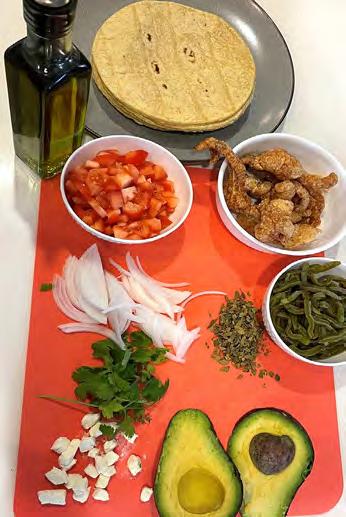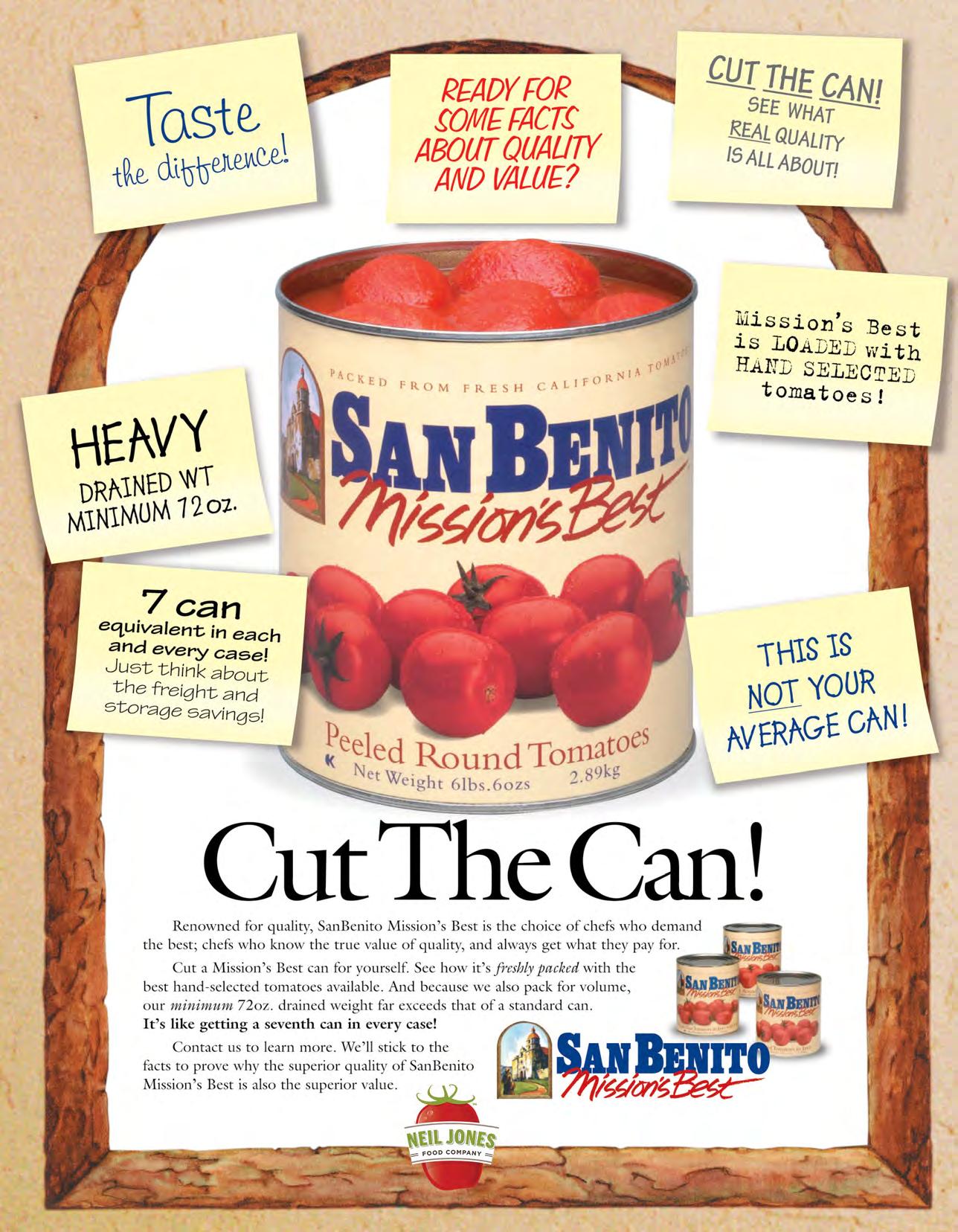
































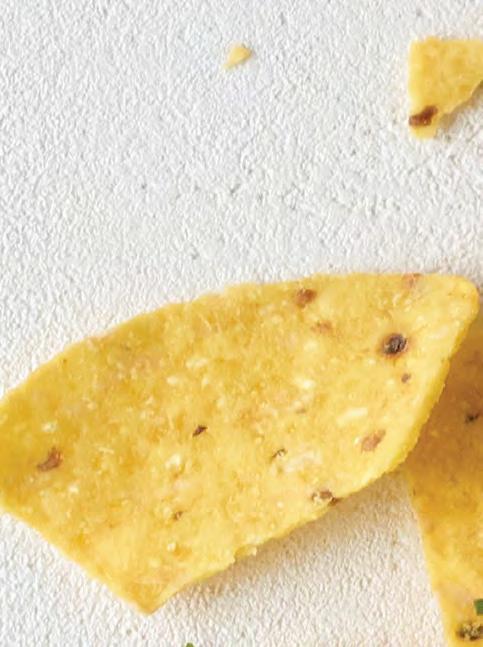
Our avocado is just like the fruit you cut, pit and scoop minus all the cutting, pitting and scooping. And that translates to some serious time and labor savings. If you want the best part of the avocado without any of the work, give WHOLLY® AVOCADO a try. It’s 100% Hass Avocado and always ready to go.

























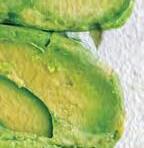




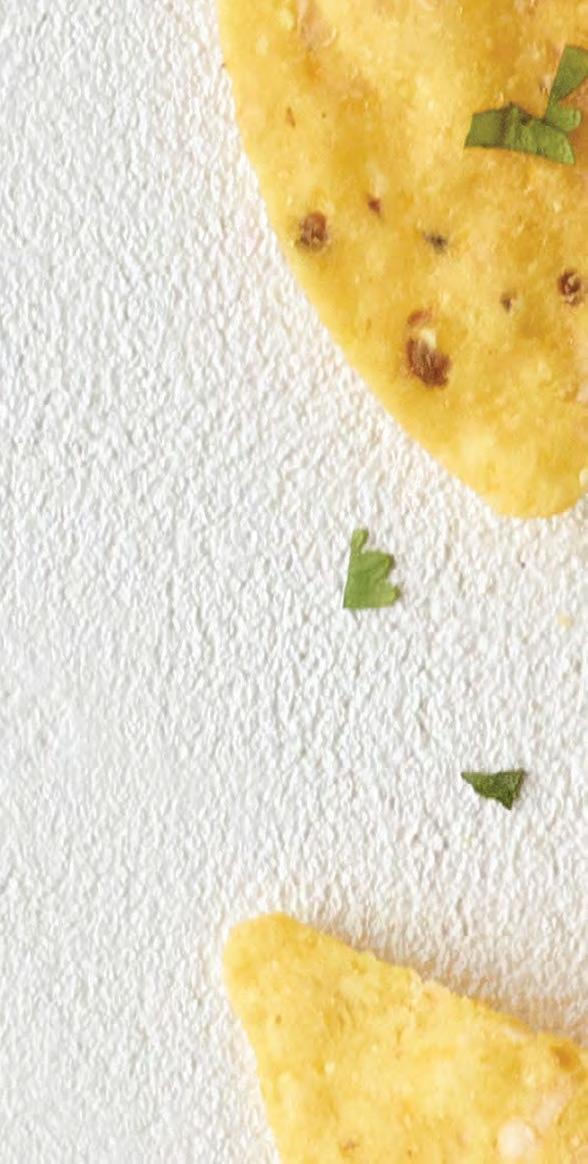









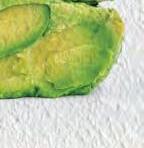
TRY IT YOURSELF. REQUEST A SAMPLE. SCAN THE CODE TO GET STARTED.






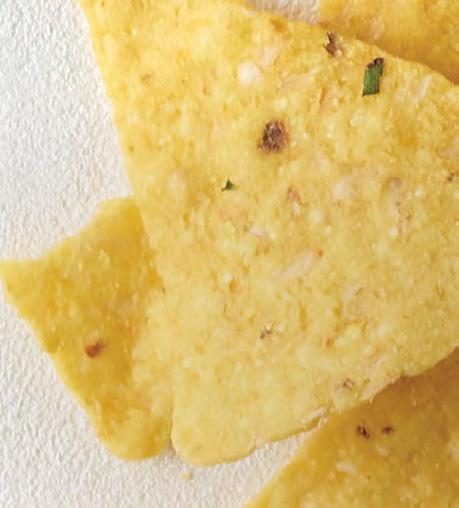




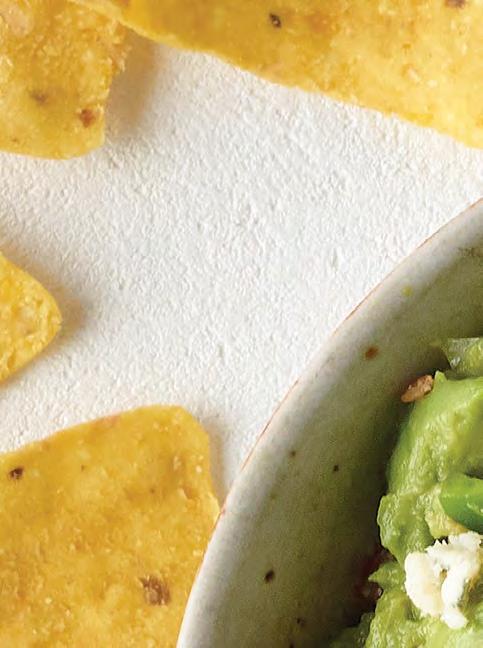
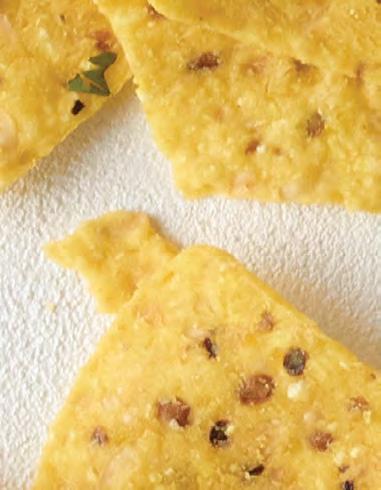

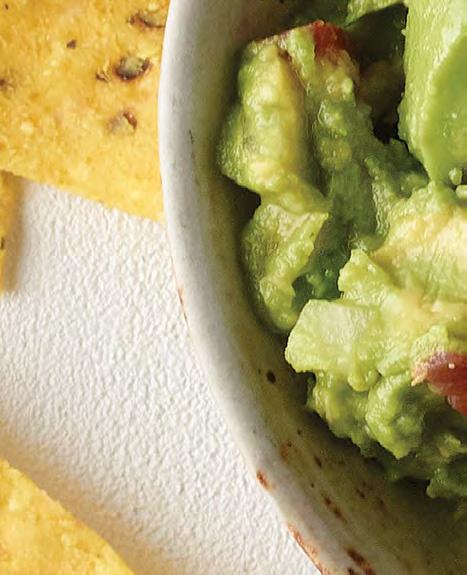
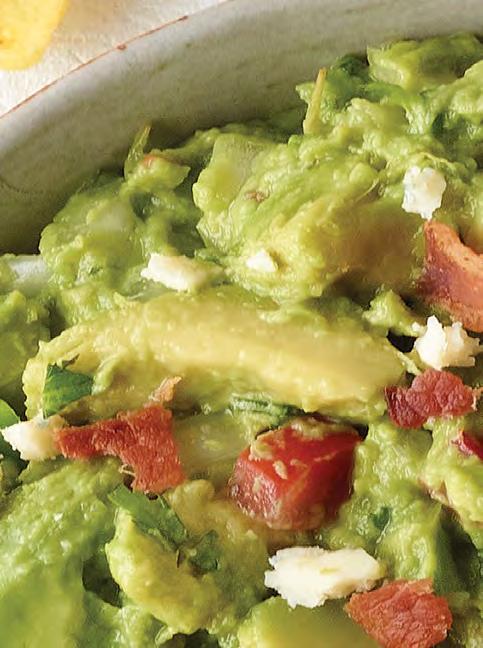
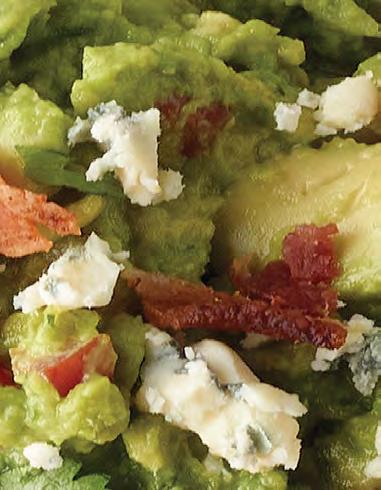

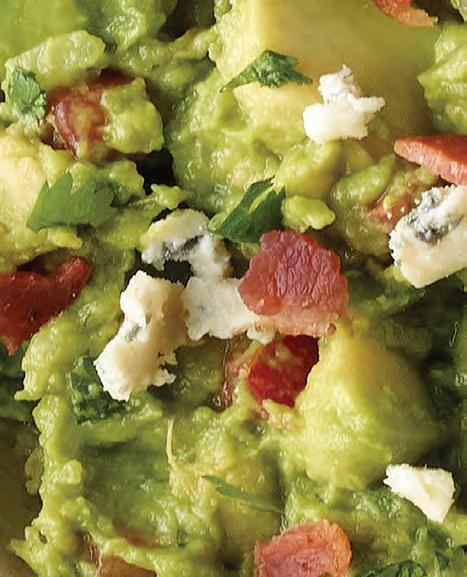



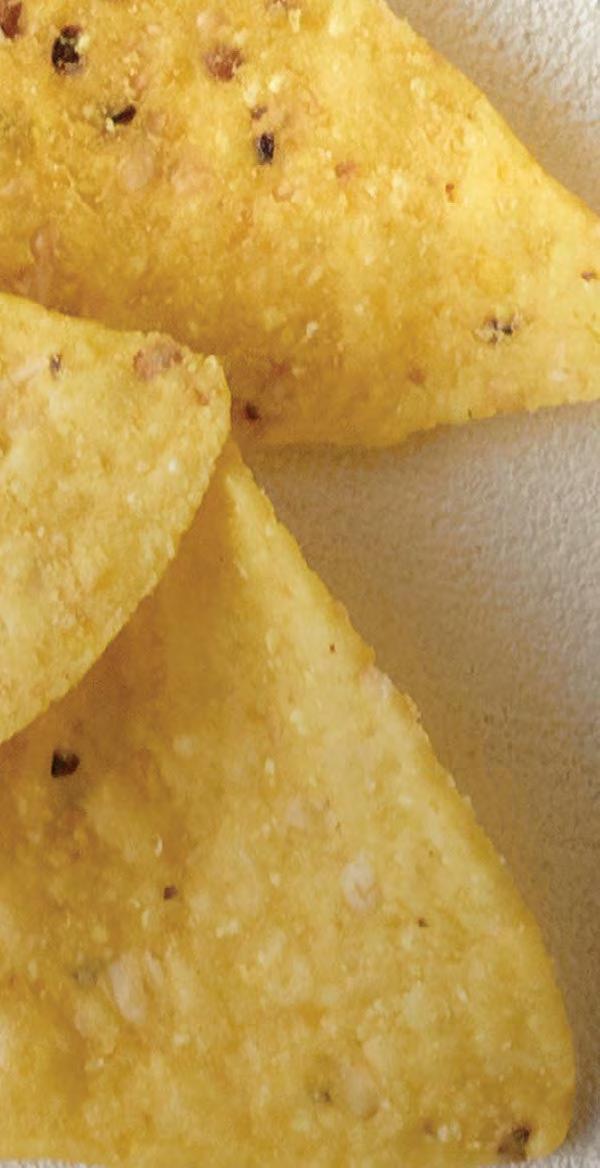

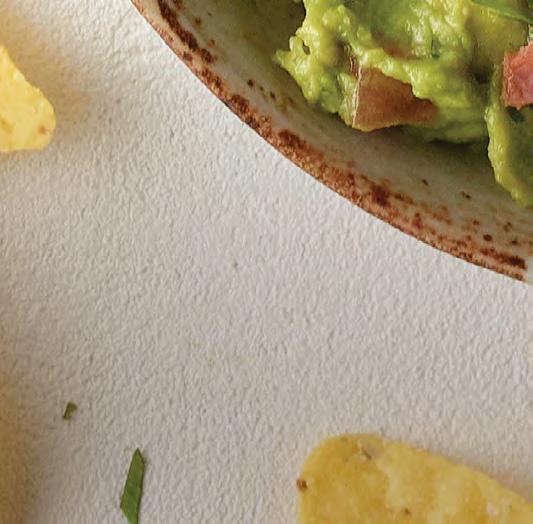




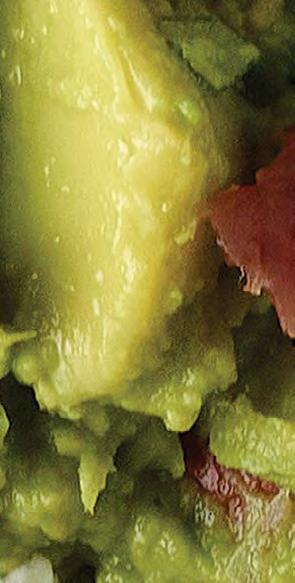








It doesn’t seem that long ago that I started my editor’s note with this simple line: “Summer is over.” But that was exactly one year ago — and now, here we are, with summer on the way out as I write this and the start of fall just a few days away.
The new season, which this year starts on September 22 and exits on December 21, presents a wealth of opportunities restaurateurs can tap to drive business. It’s time to announce new food and drink menus, host Hispanic Heritage Month and Day of the Dead celebrations, create take-out party packs and family meal offers for Thanksgiving and Christmas, and promote any catering and in-house party options your restaurant offers.
We hope the stories in this issue will help as you plan for the months ahead.
Our cover story, The Dish on Fish, dives into ways to add more fish dishes to your menu — something industry data shows consumers want restaurants to do. The Culinary Trends story about Chiles en Nogada offers tips on preparing this classic fall dish that celebrates Mexican independence and makes a perfect, celebratory LTO for Hispanic Heritage Month, which runs from September 15 through October 15.
¡Buena Idea! shows how Salena’s M exican Restaurant in Rochester, New York, is educating customers and building business in the process with Tequila Tasting Seminars with themes including Tequila & the Day of the Dead, Fall Into Tequila, and Holiday Cocktails.
At the Bar showcases 10 Mexican wines now available in the U.S. that you can add to your menu — vintages you can promote throughout the holiday season. And our Business Basics story explains how you can show customers, current and prospective, everything you’re doing by tapping the TikTok trend.
Enjoy the issue…and the fall season ahead.
PUBLISHER Ed Avis
EDITOR
Kathleen Furore
ART DIRECTOR Ala Ennes
CONTRIBUTING WRITERS
Alfredo Espinola, Paola Ortega
MAIN OFFICE phone: 708.267.0023
PRESS RELEASES TO: kfurore@restmex.com
MAILING ADDRESS P.O. Box 13347 Chicago, IL 60613
SHIPPING ADDRESS 1317 W. Belden Ave. Chicago, IL 60614
AD SALES/ENGLISH Ed Avis 708.218.7755 e davis@elrestaurante.com
Suzanne Bernhardt 678.880.9282 suzanne@elrestaurante.com
AD SALES/ESPAÑOL Alfredo Espinola 52-55-4006-9540 alfredo@elrestaurante.com
Published by Maiden Name Press, LLC Volume 27, Number 5
el Restaurante (formerly el Restaurante Mexicano) (ISSN 1091-5885) is published six times a year by Maiden Name Press, LLC 1317 W. Belden Ave., Chicago, IL 60614
All contents copyright© 2024 Maiden Name Press, LLC. Nothing in this issue may be reproduced in any form without publisher’s consent.





PARTNERSHIPS ARE ESSENTIAL TO A SUCCESSFUL
BUSINESS , and many Mexican restaurants are partnering with well-known companies to help raise their profiles. Some make a lot of sense, others not so much!

In the “makes sense” category, Tito’s Tacos in Los Angeles has been teaming up with Tito’s Handmade Vodka for the past six years. Their names are the driving force, but Tito’s is a popular vodka in a lot of Mexican restaurants, so the product connection exists, too.
The companies have created a community festival near Tito’s Tacos that doubles as a fundraiser for the Culver City Arts Foundation. Recently, the restaurant debuted Tito’s Tapestry, a short documentary about the event.
The partnership between Illegal Pete’s, a burrito-focused restaurant in Denver, and Meow Wolf, an “immersive art experience” in the Mile High City, is another match-up that isn’t all that surprising. Why? Because both businesses are known for their irreverent, fun, untraditional attitudes.
The restaurant created tie-dyed tortillas that invoke the spirit of Meow Wolf, and together they produced a video that appeals to customers of both businesses. The partnership may be expanding, too. Illegal Pete’s founder, Pete Turner, says he’s thinking of adding Meow Wolf tickets to his Starving Artists program, which feeds out-of-state musicians passing through Denver.
“So, you get fed at Pete’s and then go to Meow Wolf, which to me seems like a pretty cool hospitality gesture for people visiting Denver and probably makes Denver a more special place to these bands,” Turner said in an interview with el Restaurante

restaurant, at least theoretically.
For example, in June, Rubio’s Coastal Grill partnered with professional surfers Griffin and Crosby Colapinto to launch an exclusive new menu item, the “All-World Breakfast Burrito.” The surfing brothers exude a cool beach vibe, which is exactly the vibe Rubio’s wants to exude, too.
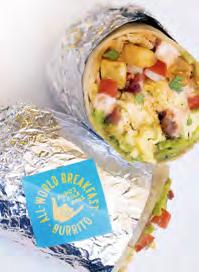
Partnerships with athletes fall into the “sort-of-makes-sense” category, since athletes’ personalities and successes rub off on the
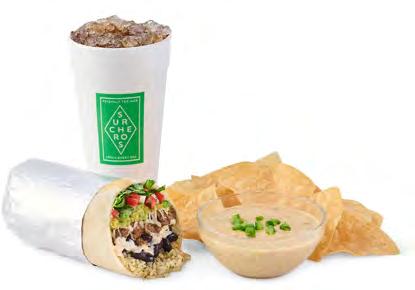
Similarly, Tex-Mex chain Surcheros has partnered with Luke Bennett, a wide receiver on the University of Georgia’s football team. The result: the Bennett Burrito and Queso “Luke’s Way” that now appear on the restaurant’s menu. Because nearly all of Surcheros’ 26 locations are in Georgia, it’s a safe bet many of their customers are Georgia football fans. A portion of proceeds from sales of both menu items will be donated to DGD Outdoor Adventures Inc., a non-profit organization that provides opportunities for underprivileged children to connect with the Georgia football program through outdoor activities. On the far end of the spectrum are the partnerships that really make you scratch your head.
Take the partnership between Moe’s Southwest Grill and Cheez-It crackers. What do cheese crackers have to do with Mexican food? Nothing. But Moe’s has decided that people might want to put Cheez-Its in their burritos or tacos — and of course they like the media attention they get from the odd pair-up.
And finally, the least sensible partnership of all is the one

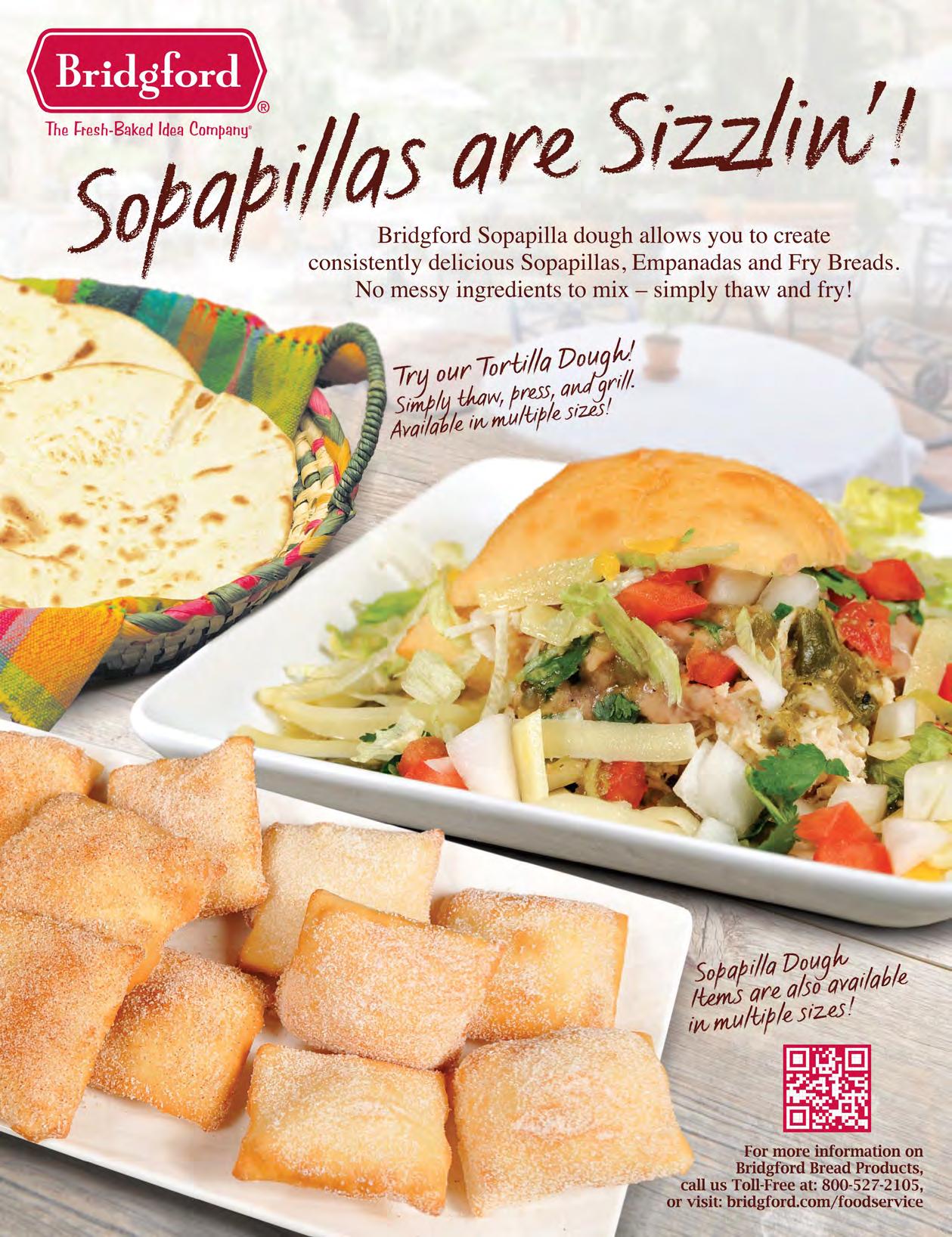
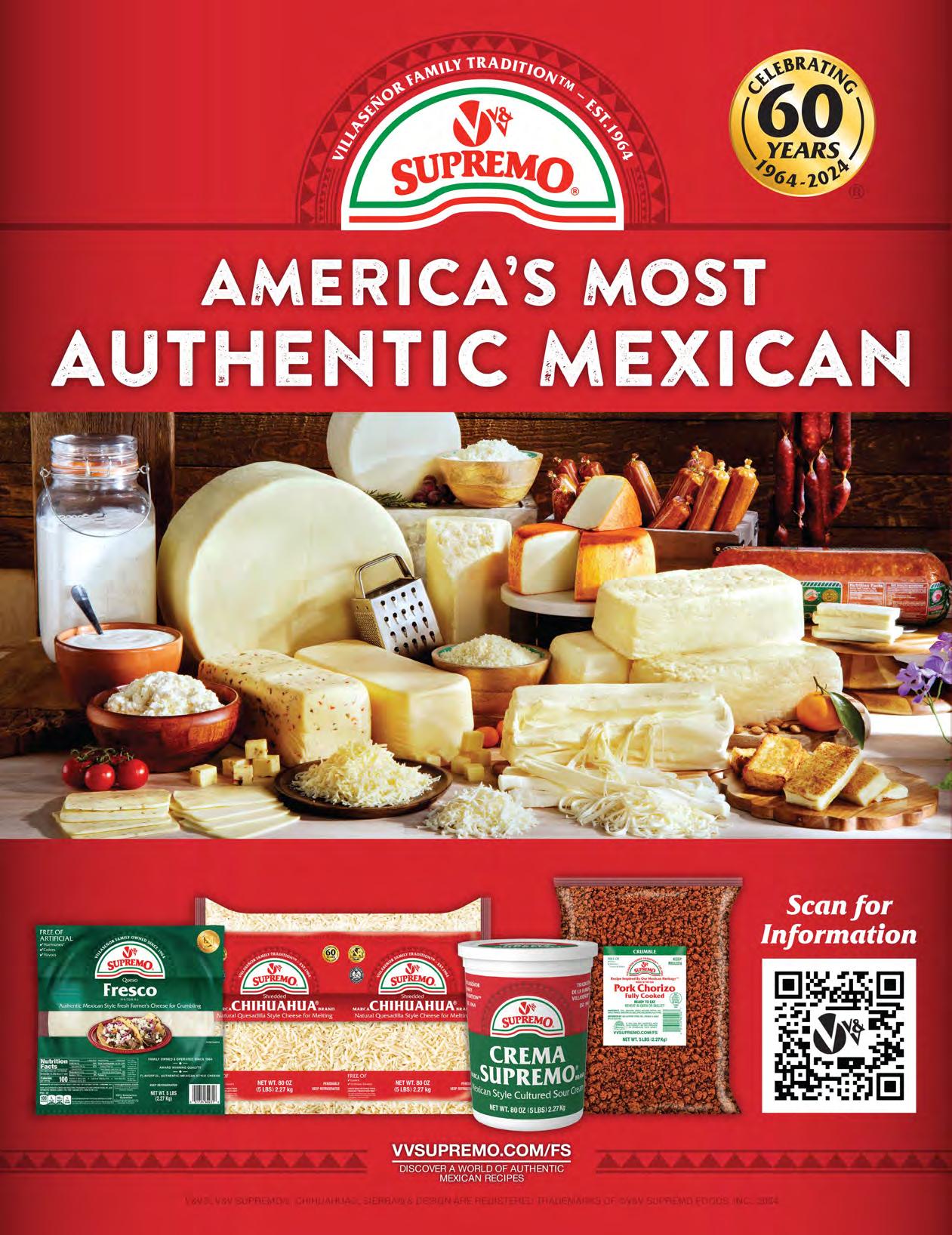
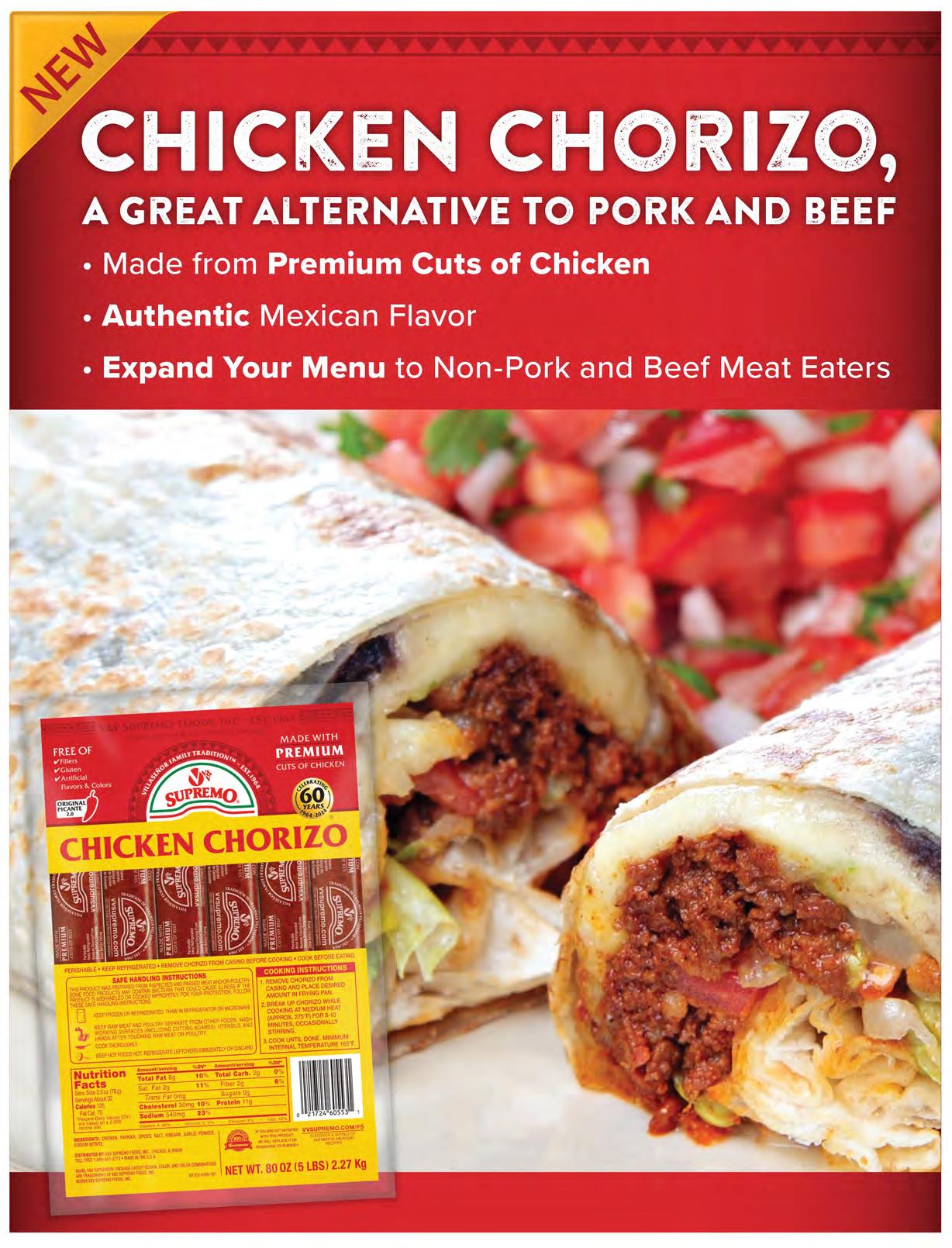

between Chipotle and Spirit Halloween. The giant costume vendor is making burrito, fork, take-out bag, water cup and napkin costumes. Has any kid ever wanted to be a napkin for Halloween? Or a fork? Probably not, but Chipotle got the idea for the costumes when a social media post showing fictional images of those costumes attracted 700,000 social engagements.
We won’t know until late October if Spirit Halloween actually sells many of the costumes, but Chipotle is getting all kinds of press about the idea. And clearly that’s the goal of any partnership — to attract attention and bring customers in the door.

The deadline for the 2024 Sassiest Salsa Contest, sponsored by Sammic, has been extended to September 30. The winner will receive a Sammic XM-52 Immersion Blender, the ultimate tool for mixing salsa! And the top three winners will get a cash prize: $750, $500 and $250, respectively. Winning recipes also will be used in our Recipe of the Week emails and published in the November/December edition of el Restaurante.
Don’t wait! To enter the contest, click here. Your recipe must be an original creation — and remember we’ll publish the winners, so don’t send a recipe you’re trying to keep secret. Experienced chefs will judge the recipes and winners will be announced in October. Good luck!
CHEF ALEX PEÑA, an artisan baker with decades of experience rooted in the rich traditions of Mexican and Central American baking, will offer two Cocina Antoja demonstrations during the Antojo Industry Trade Expo in Long Beach, California, October 13-14.
On October 13 at 11 a.m., Peña will present an immersive class on bizcocho, highlighting Mexican sweet breads, conchas and chilindrinas. On October 14 at 11 a.m., he will teach attendees the intricate steps of making pan de muerto, including the unique Tumbas variety, in a 45-minute session that will end with a tasting of bread fresh from the oven.
Peña has trained at the prestigious Richemont School of Baking in Luzerne, Switzerland, and Le Cordon Bleu in Pasadena, California. He has worked at his family’s famous La Morenita Bakery & Tortilleria in Los Angeles and in bakeries throughout the world. To register for Antojo Industry Trade Expo, click here.

Are you struggling to keep your restaurant's social media presence fresh and engaging? A free webinar — Digital Hospitality: 7 Social Media Tactics That Will Get You ALL the Customers — on October 17 at 1 p.m. Central time can help!
This webinar, part of the el Restaurante Webinar Series, will be led by Mark Sorenson from Social High Rise, a company that specializes in social media for restaurants. Sorenson will offer tips that will help you win your guests over completely and keep them coming back for more. You’ll get easy-tofollow advice that you can start using right away. Plus, you will get free tools like the Social High Rise Ultimate Restaurant Social Media Checklist and a preview of ReviewAssist.
Please click here to register for this complementary webinar.

At Performance Foodservice, we understand that community and culinary culture go hand in hand. That’s why we partner with suppliers from Mexico, Central, and South America to provide authentic, diverse ingredients for Hispanic and Latin kitchens. Our focus is on serving customers and their communities, no matter the size and scope of their restaurant. Crafting relationships continues to be the Performance main ingredient.
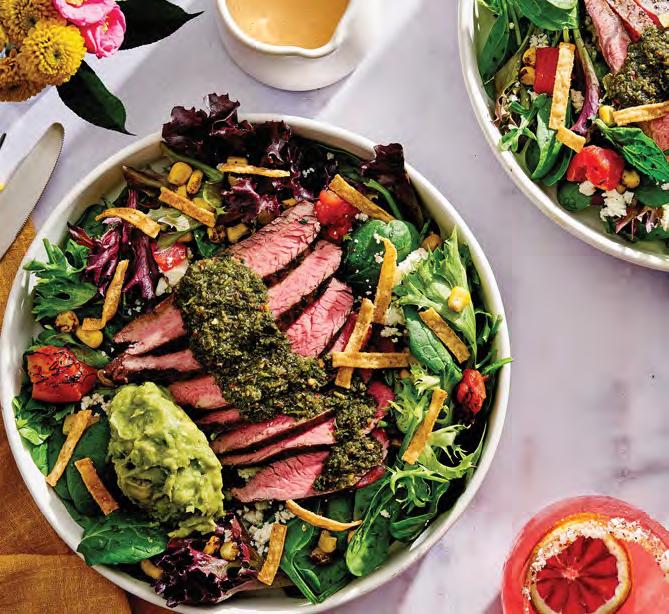
| BY KATHLEEN FURORE
| When Josh Hackler and the team at Grassfed Culture Hospitality in Miami, Florida, decided to debut a Mexican restaurant next to the company’s flagship Krus Kitchen in Coconut Grove, the mission was clear and simply stated: to pay homage to indigenous heritage.
Los Félix has accomplished that mission and more since it first brightened Florida’s culinary scene in September of 2021. The restaurant — which, as the website says, gives a “nod to the grandmothers who carried the fire of ancestral wisdom, the mothers who preserved ceremony, and the female trailblazers who embodied the fierce and the tender, by way of iconic muse Maria Felix” — was awarded a Green Michelin Star during an awards ceremony in Tampa in April.
“We view our sustainability through the lens of community well-being. How can we better enrich the communities we feed through our restaurants?” –JOSH HACKLER
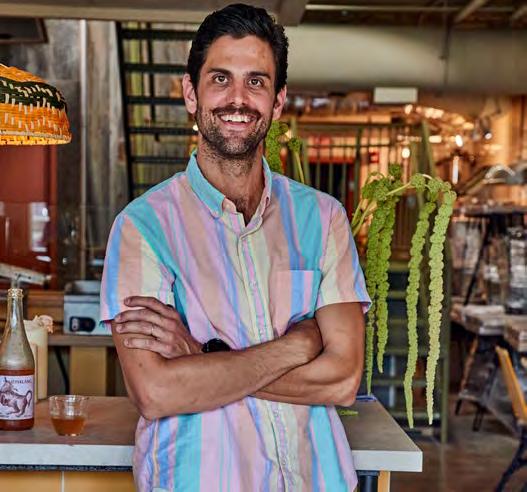
“We are the only restaurants in Miami to have a Michelin Green Star and two of three in Florida,” Hackler says, noting that Los Felix is one of 12 restaurants in the U.S. to have both a red star and green star.
The red star stands for “high-quality cooking” that’s “worth a stop!”; the green star “highlights restaurants at the forefront of the industry when it comes to their sustainable practices,” the Guide explains.

“For Los Félix, being awarded the Michelin Green Star is not just an honor; it’s a reflection of our core values and our commitment to sustainable gastronomy. It stands testament to the effort we’ve put into building a restaurant that doesn’t just serve food but nurtures the community and the environment,” Hackler continues. “This recognition matters because it underscores our dedication to sourcing locally, reducing our carbon footprint, and fostering relationships with farmers who share our ethos. It validates our belief that fine dining can be both extraordinary and environmentally conscious.”
Editor Kathleen Furore asked Hackler to explain why sustainability has been at the forefront for Los Felix and how he and his team have embraced it so successfully throughout every aspect of the business.
1When and how did you decide to make the commitment to sustainable gastronomy?
We view our sustainability through the lens of community well-being. How can we better enrich the communities we feed through our restaurants? This involves the local businesses we work with, the well-being of our staff and certainly how we think about the food and beverages we serve our guests every day. This has been our commitment from day 1. The

proteins we started working with have always been intentional — grassfed/finished, organic, heritage, wild caught locally sourced seafood, etc. Composting and recyling our waste was also something we adopted as soon as it became available, even when it didn’t make financial sense. Raising money to support Miami mothers working in the hospitality industry impacted by Covid before opening our restaurant was a huge conviction for us, as well. And lastly, developing farmer and supplier relationships before opening was something critical as well. Removing seed oils was a huge initiative that we had been working on for years and were finally able to make the transition moving into 2024.
Grassfed Culture’s mission is to restore and nourish the communities in which we operate by focusing on our tenets of passion for gastronomy, our drive for warm hospitality, the space for diversity and our constant quest for growth… while having fun along the way!
2I read that the way you honor indigenous heritage is by supporting Milpa farming. Can you explain what that means?
Milpa is an ancestral tradition of cultivating the soil with awareness of the sacred connection between self and land. The idea of Milpa centers around the harmony of vegetables flourishing the bionutrients of the farm and produce being grown. The concept is a sociocultural construct rather than simply a system of agriculture. It involves complex interactions and relationships between farmers, as well as distinct personal relationships with both the crops and land. Through Milpa, we shine a spotlight on fresh, time-honored native ingredients like heirloom corn, cacao, chiles, and squash. Our homage continues with an in-house molino where we cook and grind maiz daily to make tortillas from scratch, all in the living wisdom of Milpa to mesa, or farm to table.
For example, we are proud to have partnered with Tamoa

since day 1, bringing over one ton of maiz [from Mexico] in the last three years!
We also are creating a Milpa through our partnership with Tiny Farm in Miami to provide fruit and produce sustainably year-round, and we’re working with Paradise Farms to create a new channel of fresh dairy supply into Miami, which includes fresh butters, ghee, raw creams, raw milk, raw yogurts, etc.
Our wine selection showcases wines from the Americas, and will only be sourced from small, family-owned farms that honor the land by using natural and biodynamic methods. We also offer craft beers highlighting the best from both local and imported breweries.
3Is your commitment to these issues something that adds to food costs and other operational costs? Ulimately, it’s more expensive, but there is no compromise. For example, we work locally with Compost for Life to further


A Sammic immersion blender makes your salsa preparation easier than ever! A powerful motor, easy-to-use controls and ergonomic design mean your staff can create amazing salsas, soups and other blended menu items with ease and speed. You will love the labor savings and your customers will love the results!

First revealed in 2020, the MICHELIN Green Star — introduced into several of the 2021 editions of the MICHELIN Guide — is awarded to restaurants that hold themselves accountable for both their ethical and environmental standards. It acknowledges those who prioritize the environment and adopt practices that have a positive impact on nature and local communities. This includes working with sustainable producers and suppliers to avoid waste and reduce or even remove plastic and other non-recyclable materials from their supply chain. They consider things such as: the provenance of the ingredients; the use of seasonal produce; the restaurant’s environmental footprint; food waste systems; general waste disposal and recycling; resource management; and the communication between the team and the guests about the restaurant’s sustainable approach. Any restaurant in the MICHELIN Guide is eligible. There is no specific formula for awarding a MICHELIN Green Star, as every restaurant and its surrounding region has a unique set of conditions. The Inspectors are simply looking for those at the top of their game when it comes to their sustainable practices.
Source: The MICHELIN Guide
their and our composting mission. There’s no tax credit or city support for us to compost. For a restaurant of our size, it’s a monthly expense of $150. We try to price for it, but in certain situations there’s only so far we can take it. Ultimately people need to vote with their dollars by choosing the places that are impacting the community in which they operate for the better.
4
Is this something you make sure your customers are aware of?
And do they appreciate it in ways that have helped your business?
We try to make it clear to the guests dining in our restaurants the intention behind how we source. At Los Félix we
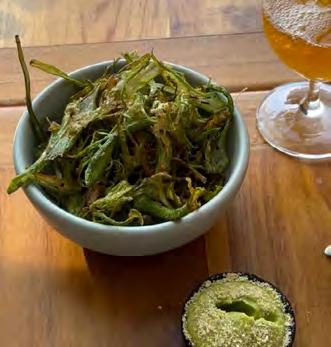
are proud and honored to carry the big responsibility of educating our guests and our teams about the importance of the decisions made daily for the environment, our communities and most importantly, our health. It is something we do not take lightly. It is our filosofía de vida Some customers are life-changed and others don’t appreciate it as much! But this is the world we live in. Focusing on the long game every day and remaining consistent is what drives us. We can’t get distracted.
5
Any advice for Mexican/Latin restaurants — small independents in particular — who want to be more sustainable enterprises?
Start with the basics. What proteins are you using? What oils are you using? How are you handling your waste? What small steps can I take knowing that I’m doing one of the most important jobs in the world, which is feeding people?
Watch Los Felix staff explain what the Michelin Green Star means to them: www.instagram. com/p/C_Ql7OOOFY0/

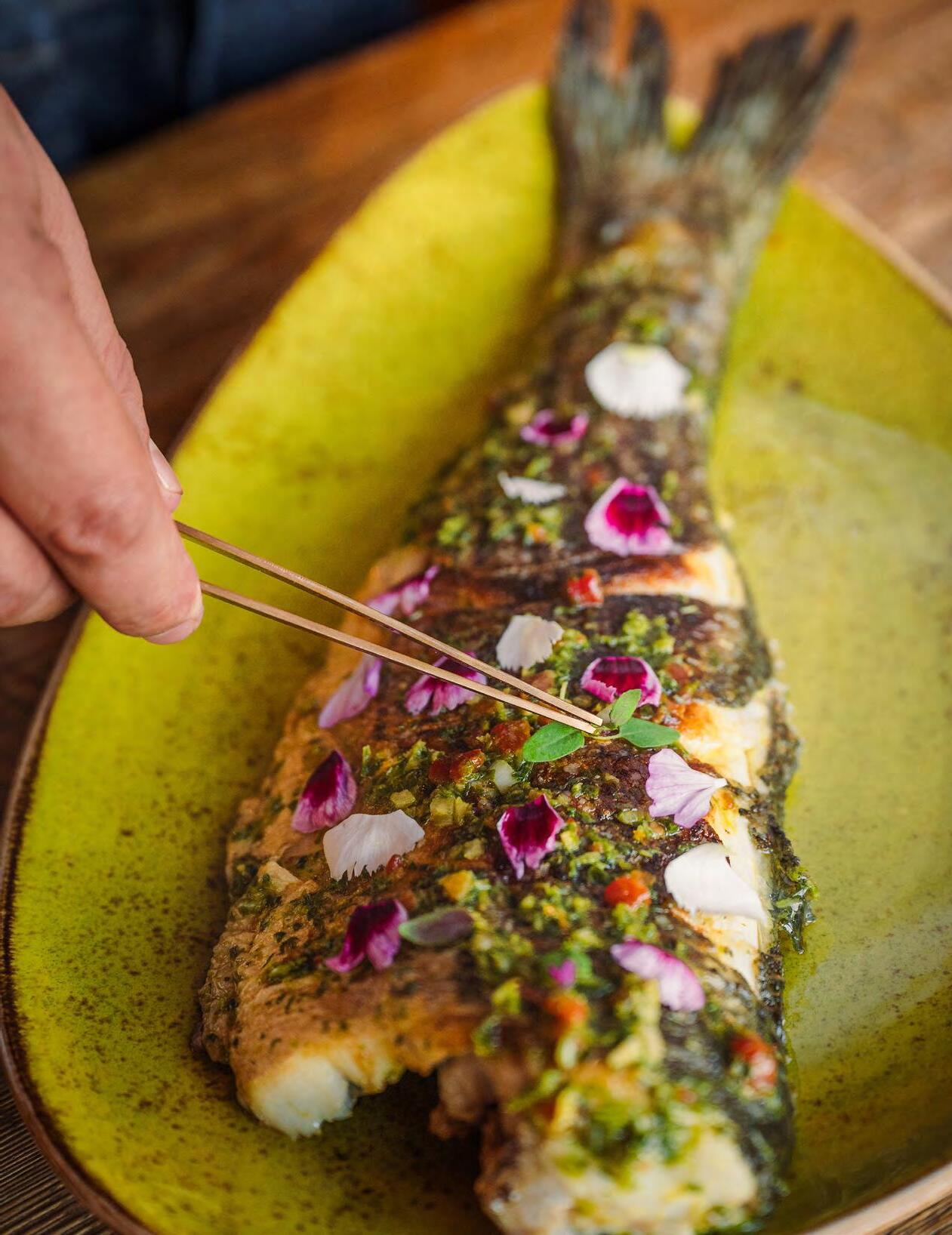
WANT MORE OPTIONS ON THE MENU
| BY KATHLEEN FURORE
| When fish-loving consumers are deciding where to dine, your Mexican restaurant might not be the first spot that comes to mind. Because even though fish is an important ingredient in authentic Mexican cuisine, there often aren’t a lot of fish choices on Mexican restaurant menus.
A review of recent seafood consumption data from Alaska Seafood Marketing Institute shows that perhaps there should be. Forty-three percent of today’s consumers are limiting or avoiding meat consumption, with wild seafood and sustainable seafood topping the list of nonmeat proteins consumers prefer, ASMI reports.
And when it comes to how those consumption preferences relate to foodservice, the data for casting a wider net for fish dishes is even more convincing.
Consumers say they want more seafood entrees and appetizers on the menu compared to other proteins across all segments, and in the fast-casual segment, they want more seafood tacos on the menu compared to other protein tacos.
Overall, 25 percent of consumers are ordering more seafood at restaurants than they did two years ago, and those numbers are even higher for Gen Z and Millennial consumers: 29 percent of Gen Z and 31 percent of Millennials have increased seafood consumption during that time frame.
And according to ASMI, consumers who are ordering fish spend 34 percent more on their meal than diners who don’t!
There are many reasons to add more fish to your menu.
Executive Chef Ben Diaz of Temecula Creek Inn in Temecula, California, lists its health benefits as one of the biggest.
“Seafood is a lean protein packed with omega-3 fatty acids, is low in saturated fat, has a lower cholesterol count than most meats, and is packed with vitamins such as vitamin A and vitamin B which aid in brain and eye health,” Diaz says.
Consumers agree.
“Seafood is healthier than other proteins” is the #1 reason consumers cite for increased seafood consumption, ASMI data show.
Diaz says adding variety to the menu is another reason to expand fish selections. Jenny Di Sapio, who co-owns Chicago’s Bodega Sur with her brother, Sergio, agrees.
“People want to have choices when they go out to dine,” says Di Sapio. “Some people aren’t comfortable, or used to,
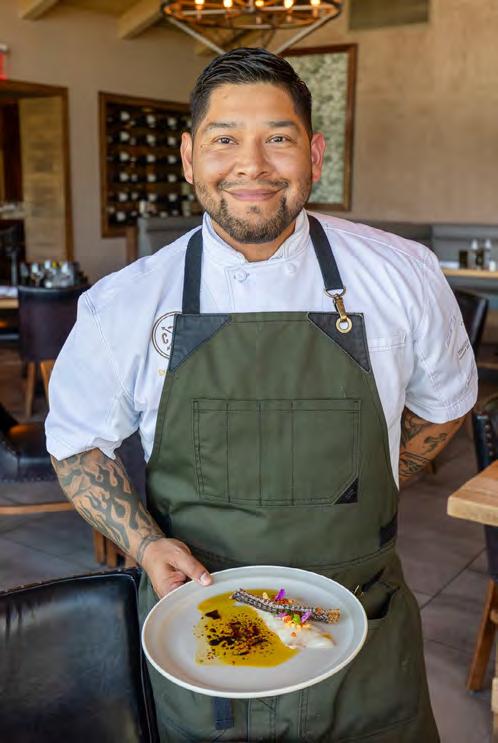
“One trick I use is to offer up a prix-fixe menu with things that your diners recognize and then add your seafood option in as an appetizer or starter. This way, your diners get to have something they enjoy and at the same time try something they normally would not order.”
– BEN DIAZ,
Temecula Creek Inn
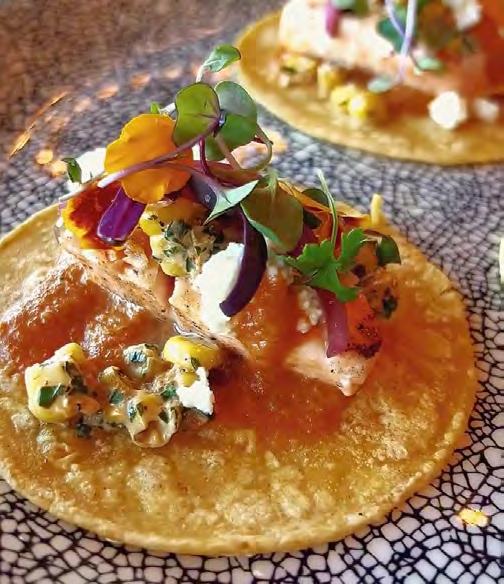













OUR MOLE IS A LABOR OF LOVE.
WE DO ALL THE LABOR. YOU GET ALL THE LOVE.
When it comes to mole, time is your most important ingredient. But who has the hours and hours it takes to get it right? We do. And we take the time to make it the right way so you can share it the easy way. DOÑA MARIA® Mole Rojo promises the truly authentic flavors of a generations-old family recipe in just a matter of minutes.


ASK FOR A TASTE
RICH FLAVOR
The flavor of the fish on your menu is ultimately what matters most. But if you can’t get customers to order it, all the work that goes into prep won’t matter.
That’s why how you describe your fish dishes is important. According to Alaska Seafood Marketing Institute (ASMI), 63 percent of diners says they would order more fish if they knew its origin.
“For restaurants that have wild-caught or sustainable fish, I recommend noting it on the menu,” says Jenny Di Sapio, co-owner of Chicago’s Bodega Sur. “Because of the practices used to source it, the dish may be a bit pricey, coming from a smaller-sized purveyor, not from a big
company. But knowing where it’s coming from and why it’s priced as such will help people understand the price point. And ultimately, everyone wants a good fish.”
Ben Diaz, executive chef of Temecula Creek Inn in Temecula, California, also makes a point of identifying the source of the fish on his menu.
“It is always a great idea to highlight the ingredient’s origin; Mexico, for example, sits on two sides of the coast and has a great peninsula where you will find an abundance of amazing seafood,” Diaz says. “Noting the origin makes that connection with your diners all that more special, especially if it’s from a source they know or have heard of, which makes them more likely to try the product.”
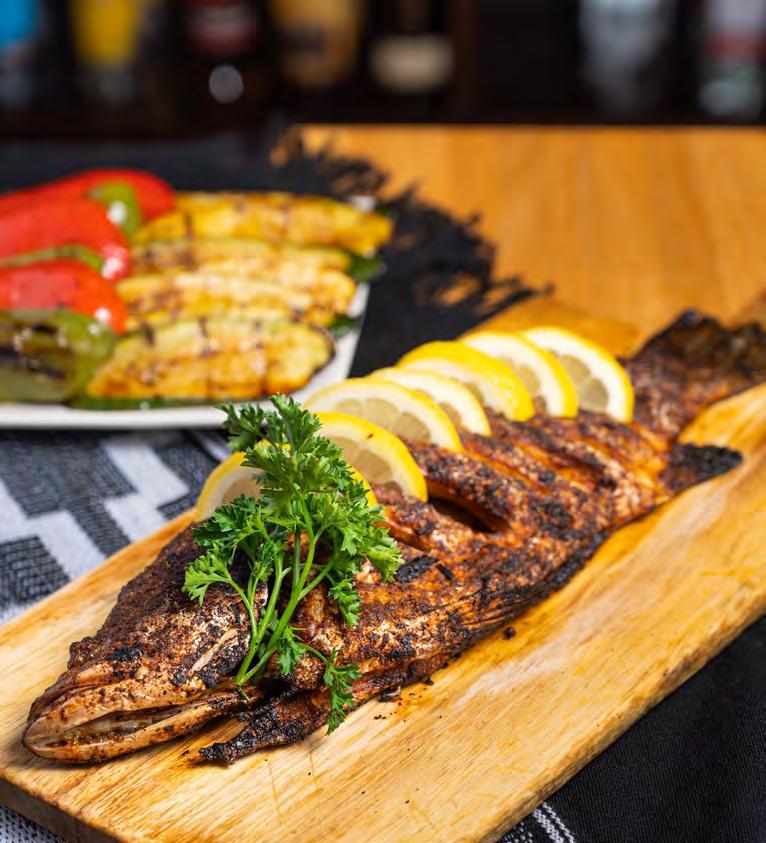
cooking fish at home, so restaurants should be able to present them with options when they dine out. I think people appreciate well-made fish, and they like to enjoy it in a place that can cook it for them.”
No matter the reason, there are many ways chefs can showcase the role fish plays in Mexican fare.
“Mexico has various regions…Each fishing town is completely different from the next,” explains Diaz, who notes that there are local cooking adaptations unique to each region and even each town. “Exploring these and bringing some of those bright fresh flavors to your menu can help your diners build a positive connection.”
Ceviche, pescado frito, and poblano salmon are three dishes he recommends.
Di Sapio suggests starting with salmon or halibut — two types of fish that often appeal to diners who aren’t necessarily big fish fans.
“Some good options for initially adding fish to the menu could be salmon, or halibut — filets are always popular. They give people the feeling of enjoying a steak and tend to be more approach-
able than a whole fish,” she says. Bodega Sur, for example, has a salmon filet on its regular menu and also has featured specials with mahi mahi and other filets.
“The best way to start is to add one item and then build on that,” says Diaz, who also suggests asking customers for feedback and then slowly introducing other options.
Whether diners are fish aficionados or just dipping a toe into that culinary pond, many worry that fish won’t be good unless it’s fresh — which means they might be hesitant to order fish if they’re not dining at a restaurant on one of the coasts.
How can restaurants dispel that concern and find the best fish for their location, no matter where in the country they’re located?
Finding reputable suppliers you know you can trust is task #1, Diaz and Di Sapio stress.
“Next would be showcasing the product with familiar notes such as local produce,” says Diaz, who takes a creative approach to introducing fishleery diners to new dishes.
“One trick I use is to offer up a prixfixe menu with things that your diners recognize and then add your seafood option in as an appetizer or starter,” he says. “This way, your diners get to have something they enjoy and at the same time try something they normally would not order.”
There’s also the fear of the price — at least that’s what Di Sapio has found.
“One interesting thing I noticed is that when we used to price our fish at ‘Market Price,’ people didn’t seem to order it as much. They were too nervous to ask, or worried the price would be exorbitant, when in reality it wasn’t,” she
says. “We changed the way we priced it just due to people not wanting to inquire, and more people order it since.”
So, are there any secrets to cooking fish to make sure it delivers the best flavor and texture for diners — those who have always loved fish and those just starting to dive in?
“This is always a fun [question] because I love to explore various techniques and flavor combinations,” Diaz says. “For fish with a meatier texture I prefer grilling or roasting over open flame; flaky fish are best cooked in a
“Some good options for initially adding fish to the menu could be salmon, or halibut — filets are always popular. They give people the feeling of enjoying a steak and tend to be more approachable than a whole fish.”
– JENNY DI SAPIO, Bodega Sur
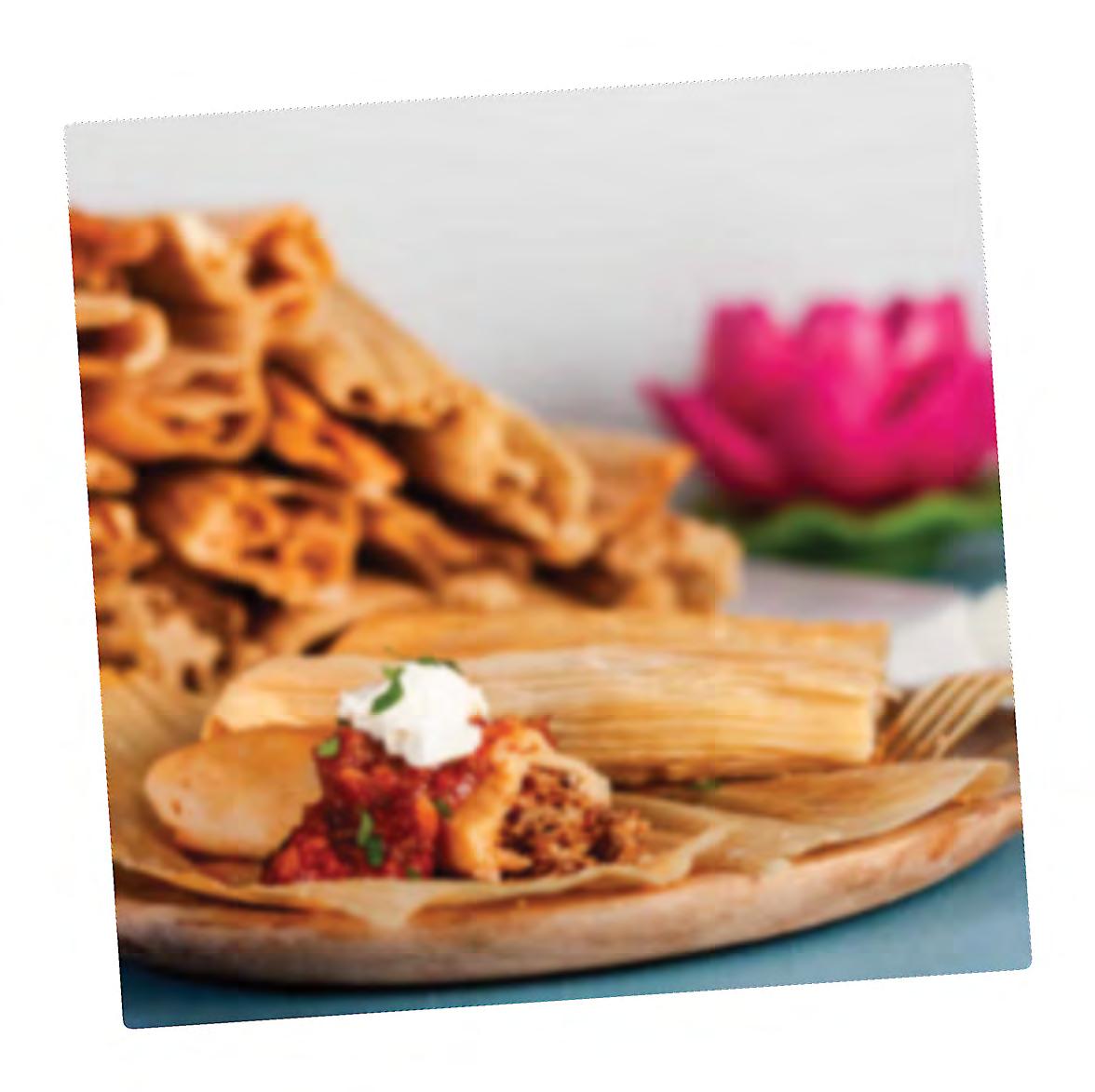







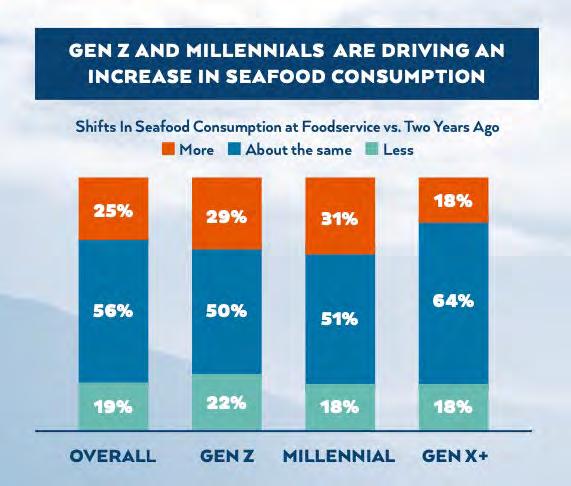
Source: Alaska Seafood Marketing Institute
His Roasted Pacifico Striped Bass with Salsa Para La Mesa is one example of a flaky fish enhanced by baking. Diaz brushes the fish with olive oil; coats it with a wet rub of lemon zest, lime zest, guajillo powder, brown sugar, kosher salt, minced rosemary and garlic paste; marinates it for one hour; then bakes it on a parchment paper-lined pan. (See recipe on page 45.)
And there’s always the question — with or without the head?
“I prefer fish with the head!” Di Sapio says. “I highly recommend restaurants consider that option because I feel it makes it more real, more authentic — and the flavors tend to stay in the fish for customers to enjoy. People tend to fear the bones in a whole fish dish, but it doesn’t have to be scary. It’s a cool, fun way to consume fish.”
Bodega Sur’s Pescado Al Limon — complete with head — is one example. “We use Barramundi fish, which is a seabass from the Australian coast. We put a rub on it, just simply made with salt, pepper, some Cajun spices and peppers, but not enough to make it spicy, add a little bit of oil, and bake it in the oven. We serve with a side of grilled veggies, so it’s healthy and delicious.”
“As for the age-old question head on or head off, I lean more on my diners to give me directions. It really depends on what part of the country you are in and what your diners prefer,” Diaz says. “For example, here in southern California it is more common to see fish without the head; but travel two hours south into Baja and it is more common to see fish with the head still on. Cultural difference also play a big role in this. If you’re still not sure I say just go for it!”
| BY ALFREDO ESPINOLA AND KATHLEEN FURORE |
Chiles en Nogada season has begun — just in time to celebrate Mexican Independence Day on September 16 and Hispanic Heritage Month, which runs from September 15 to October 15 this year.
Made with ingredients including poblanos, pomegranates, and a sauce made of walnuts (the green, red and white of the Mexican flag), Chiles en Nogada dates to 1821, the year nuns in Puebla created it to celebrate Mexico’s Independence and emperor Agustín de Iturbide.
More than two centuries later, restaurant kitchens are turning out the celebratory dish with recipes that recall the original while sometimes putting modern spins on the classic.
EL NARANJO MAKES THE CLASSIC
At El Naranjo in Austin, Texas, celebrated Chef Iliana de la Vega’s Chile en Nogada makes a brief appearance on the lunch and dinner menus exclusively in September every year.
“We have loyal customers who return every year,
“We
have loyal customers who return every year, often asking in advance when the dish will be available. Newcomers usually get hooked and return the same month or the following year.”
– CHEF ILIANA DE LA VEGA
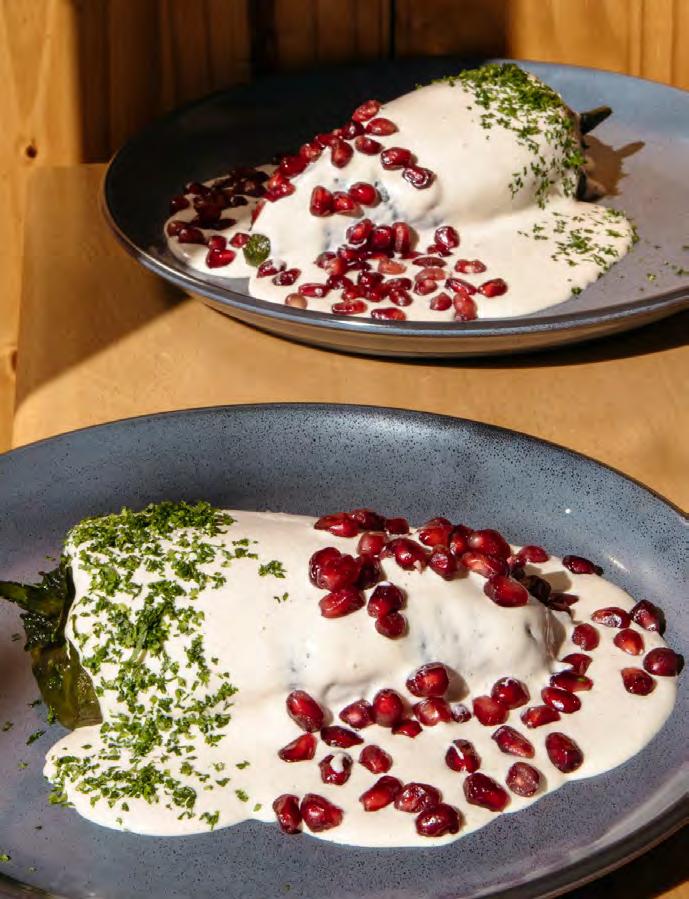
often asking in advance when the dish will be available. Newcomers usually get hooked and return the same month or the following year,” de la Vega says, noting that she follows a traditional recipe as closely as possible.
“In Mexico, the walnuts used are fresh and peeled throughout the season, but that’s not possible in the U.S., so I use them as they are here,” she continues. “There’s also a national debate in Mexico about whether the chiles should be egg-battered and fried. I prefer not to batter them. If you do decide to egg batter, make sure to do it at the last minute, just before serving.”
She also cautions against taking shortcuts. “It’s a classic dish…It requires a bit of work, but it’s absolutely worth the effort,” she says.
Velas Resorts in Puerto Vallarta, Mexico, is honoring the Chile en Nogada with the classic recipe plus six dishes and a signature cocktail available through September 22.
Chile en Nogada Pizza: A pizza base of tomato and oregano sauce mixed with Chile en Nogada and gouda cheese filling, topped with poblano bell pepper strips, walnut sauce, pomegranate and fresh parsley leaves
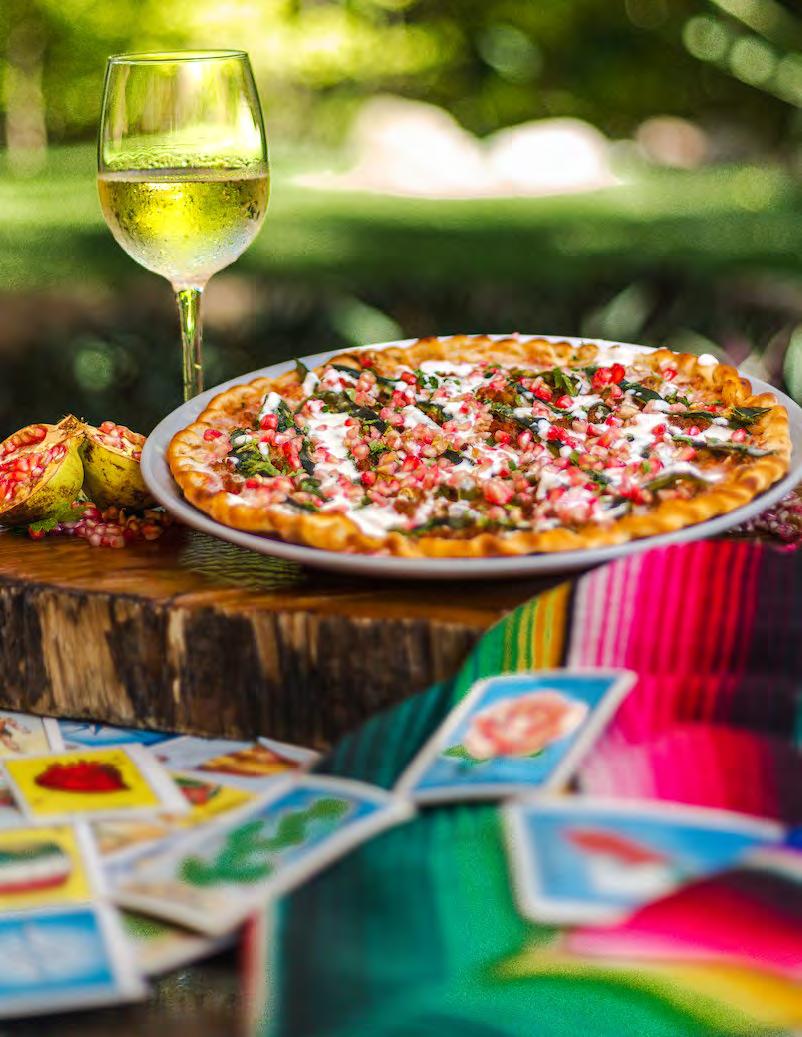
Crepa de Nogada: A crepe filled with cream cheese and dehydrated fruits, finished with sweet nogada sauce and pomegranate seeds
Enchiladas de Nogada: Three tortillas wrapped around Chile en Nogada filling, topped with nogada sauce and poblano bell pepper strips, then sprinkled with pomegranate seeds and parsley leaves
Tamal de Nogada: A corn husk tamale filled with Chile en Nogada filling and rajas, topped with nogada sauce, pomegranate, and parsley leaves
Pellizcadas de Nogada: A fried masa “sope” base stuffed with Chile en Nogada filling, topped with nogada sauce, poblano bell pepper strips, pomegranate seeds, and parsley leaves
Helado de Nogada: Creamy ice cream with the traditional flavor of nogada sauce sweetened and sprinkled with pomegranate
Dragon Ball Cocktail: Pomegranate liqueur, dragon fruit, pickle juice, gin, tonic water, and fresh pomegranate
Restaurants in the State of Puebla — the birthplace of Chiles en Nogada — are taking creative license with fillings that range from salty to sweet.
Restaurante Restauro: Traditional filling of creole fruits and ground beef and pork, covered by a light capeado and bathed with nogada full of nutty flavor
Restaurante la Textilería: Sweet but balanced filling characterized by pine nuts, topped with a lightly textured nogada with a touch of port, then garnished with fried parsley for a crunchy texture
Restaurante la Noria: Special combination of beef, fruit and a touch of piloncillo, topped with a non-liquor nogada that highlights the walnut flavor with extra pieces of walnut







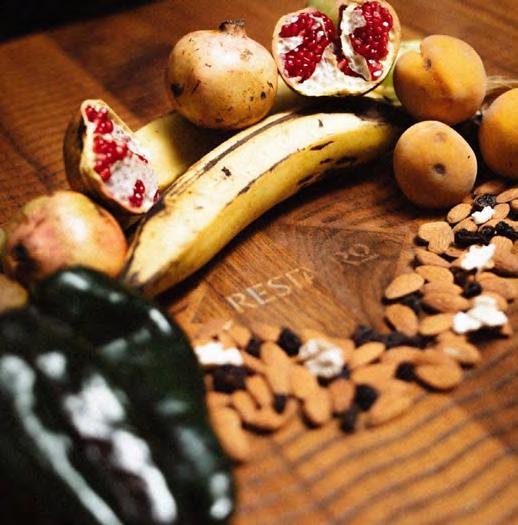








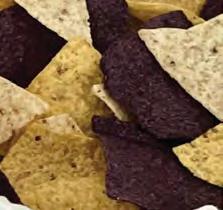



| BY KATHLEEN FURORE | More than a decade ago, Aaron Metras, owner of Salena’s Mexican Restaurant in Rochester, New York, launched tequila classes to educate customers about the nuances of the popular Mexican spirit. Today, those monthly classes — which explain the history of tequila and agave, how the products are made, and what makes a tequila good or bad — are still entertaining and educating patrons who also get to enjoy samples of the spirits, along with chips and salsa, all for just $35 per ticket. The most recent session

“We do a class once a month and they always sell out at 16 people. We also do several private classes a year. They are great for business. Not only are we able to educate our guests about a core product, but the classes allow us to build relationships with the guests, as well.”
– AARON METRAS
focused on agave; upcoming classes include Tequila & the Day of the Dead, Fall Into Tequila, and Holiday Cocktails.
The events have been so popular that Salena’s has added corporate team building workshops that show how companies can apply the lessons of quality tequila production to help their teams, too.
Here, Metras explains the genesis of the classes and how the events continue to educate customers while building business at Salena’s.
el Restaurante: How did you come up with the idea for the seminars 10+ years ago?
Aaron Metras: We realized that there was a lot of misinformation out there. We had had our own bad experiences with mixto tequila and thought we didn’t like it. As we learned about tequila and its cultural history, we felt it was a story to be shared. We took a few distillery tours and were hooked — and we wanted to hook other people also.

Votar es la forma más poderosa que tiene la gente para expresar sus opiniones en los Estados Unidos. Al votar por candidatos en los que cree y en cuestiones que le interesan, puede lograr un impacto en cómo se gobierna nuestro país. Las próximas elecciones determinarán quién dirigirá Estados Unidos en los siguientes años y qué cuestiones recibirán atención. Asegúrese de que está registrado para votar e invite también a sus amigos, familia y empleados a registrarse.
Para consultar información sobre cómo registrarse, visite gobierno.usa.gov/requisitos-inscripcion-votar
Este anuncio está patrocinado por la revista el Restaurante y la Latino Food Industry Association.
Voting is the most powerful way for people to express their opinions in the United States. By voting for candidates you believe in and issues you care about, you can impact how our country runs.The upcoming elections will determine who leads America in the coming years, and which issues get attention. Make sure you are registered to vote, and encourage your friends, family, and employees to register, too.
For information about how to register, visit www.usa.gov/register-to-vote
This advertisement is sponsored by el Restaurante magazine and the Latino Food Industry Association.

• Manual Dough Divider (36-part head included)
• Dough Rounder
• Portable Stand (with casters)
• Manual Tortilla Press (15-inch square platen, swing-away design)
• Tortilla Press Cart


We put together a loose curriculum mostly for staff. In 2014, my brother did a bartender-to-work program through Fortaleza and when he came back he took over the classes. He created an amazing presentation which is the outline of what we follow today.
el Restaurante: How do the classes work? Do tequila companies help fund the events and make presentations? Metras: Our classes consist of 7½-oz. tastings over an hour and a half to two hours. We review the entire process of tequila making from growing and harvesting the agave to distilling. We discuss all the ways the different steps of the process impact the final product. Throughout the class, we explore guided tastings, focusing on aroma and palate. We include a variety of ages of tequila, and depending on the class we may include mezcals and agave spirits.
I wish more tequila companies funded the events, but the ones most willing to do so are the big budget, mass produced companies. Most of our classes focus on the traditional processes used by smaller distillers. These distillers tend not to have large advertising budgets, so we put them on ourselves. Occasionally, we will have brand participation.
“We realized that there was a lot of misinformation out there. We had had our own bad experiences with mixto tequila and thought we didn’t like it. As we learned about tequila and its cultural history, we felt it was a story to be shared.”
–AARON METRAS
We had Alan Camarena of G4 Zoom in for a class and we have done lineups with Casa Noble.
el Restaurante: How popular have the classes been with customers? Do you think they’ve helped grow your business?
Metras: We do a class once a month and they always sell out at 16 people. We also do several private classes a year. They are great for business. Not only are we able to educate our guests about a core product, but the classes allow us to build relationships with the guests, as well. I have had numerous guests return to another class, sometimes three or four times!
el Restaurante: You also started the corporate workshops. When did those start and how do they work?
Metras: In the post-Covid era, we are always looking for the best ways to engage customers in new ways. My wife and I put together our backgrounds in human services and development and created a workshop using the principles of well-made tequila. Focusing on quality and adherence to tradition sometimes creates a tension with modernization and efficiency and these lessons transfer to almost any organization. There is a balance that must be achieved. Self-reflection and tequila create a great combination! Some activities include creating a personal profile based on your “Margarita type,” exploring communication through aroma and taste descriptions, and problem solving based on real-life scenarios faced in the tequila industry.
el Restaurante: Do you have any examples of companies that have participated and why they chose to take the workshop?
Metras: Nurses seem to be the most popular group, followed by teachers and corporate teams. I think it appeals to folks in high stress jobs.


| BY ED AVIS | Mexican wine has been growing in importance among U.S. restaurants for the past decade, but one complaint keeps coming up: Mexican wine is hard to get here. That statement is true, to an extent. Mexican winemakers do not produce in the same quantities as those in Argentina, Peru or Australia, so the amount that’s available for export is less. And while there are some excellent large wineries with a history of export — such as Casa Madero and Monte Xanic — in general, Mexican wineries tend to be small, boutique businesses, many of which cater to on-premise visitors rather than the export market.
Those small wineries have been enjoying the most attention in recent years — especially as wine-loving tourists have discovered them — so if you could put wines from these wineries on your menu, it would be a great way to start a Mexican wine list.
Fortunately, a growing number of those boutique wineries are now producing reliable quantities and exporting to the United States. Below is a list of 10 wines, from various regions in Mexico, that have been recommended by Tom Bracamontes, owner of La Competencia Imports. Bracamontes has been making a point of expanding the breadth of Mexican wines available in the United States by looking beyond Valle de Guadalupe and other trendy regions.
These 10 wines are widely available throughout the U.S. from major wine distributors, though each wine is not available in every state. Ask your distributor about availability.
El Bajio Sparkling Brut (Querataro). This wine, exclusively available in the U.S., is part of collaborative effort between La Competencia Imports and Freixenet de Mexico. The grapes are 50 percent Macabeo, 40 percent Xarel-lo, 10 percent Ugni Blanc. According to tasting notes, this wine is “bursting with aromas of Meyer lemon flowers, jasmine, pear, and hints of Brioche bread.” The importer suggests pairing it with appetizers, fish tacos, sushi, and/or tapas. Retail price: $25 to $30.
Bruma Ocho Rose (Baja California).The Bruma winery in Valle de Guadalupe is well known to lovers of Mexican wine. This rose is made from 100 percent Sangiovese grapes and is aged six months in stainless steel tanks. The tasting notes say, “Light lychee color, expressive notes of unripe strawberry, white tea, grapefruit and fennel.” Retail price: About $25.

Casa Magoni Chardonnay Vermentino (Baja California). Casa Magoni is another famous winery in the Valle de Guadalupe. This white blend, made with 80 percent Chardonnay and 20 percent Vermentino grapes, is described as “a fresh and elegant white, with notes of green apple, grapefruit peel, tropical fruits (pineapple) and white flowers.” Retail price: $20 to $30.
Bodegas Henri Lurton Sauvignon Blanc (Baja California). This winery, founded by French winemaker Henri Lurton, makes top-flight wines such as the Sauvignon Blanc. The tasting notes say, “notes of grapefruit and jasmine with a hint of minerality and cassis buds, [which] gives it an extra layer of aromatic richness.” Retail price: $30 to $35.
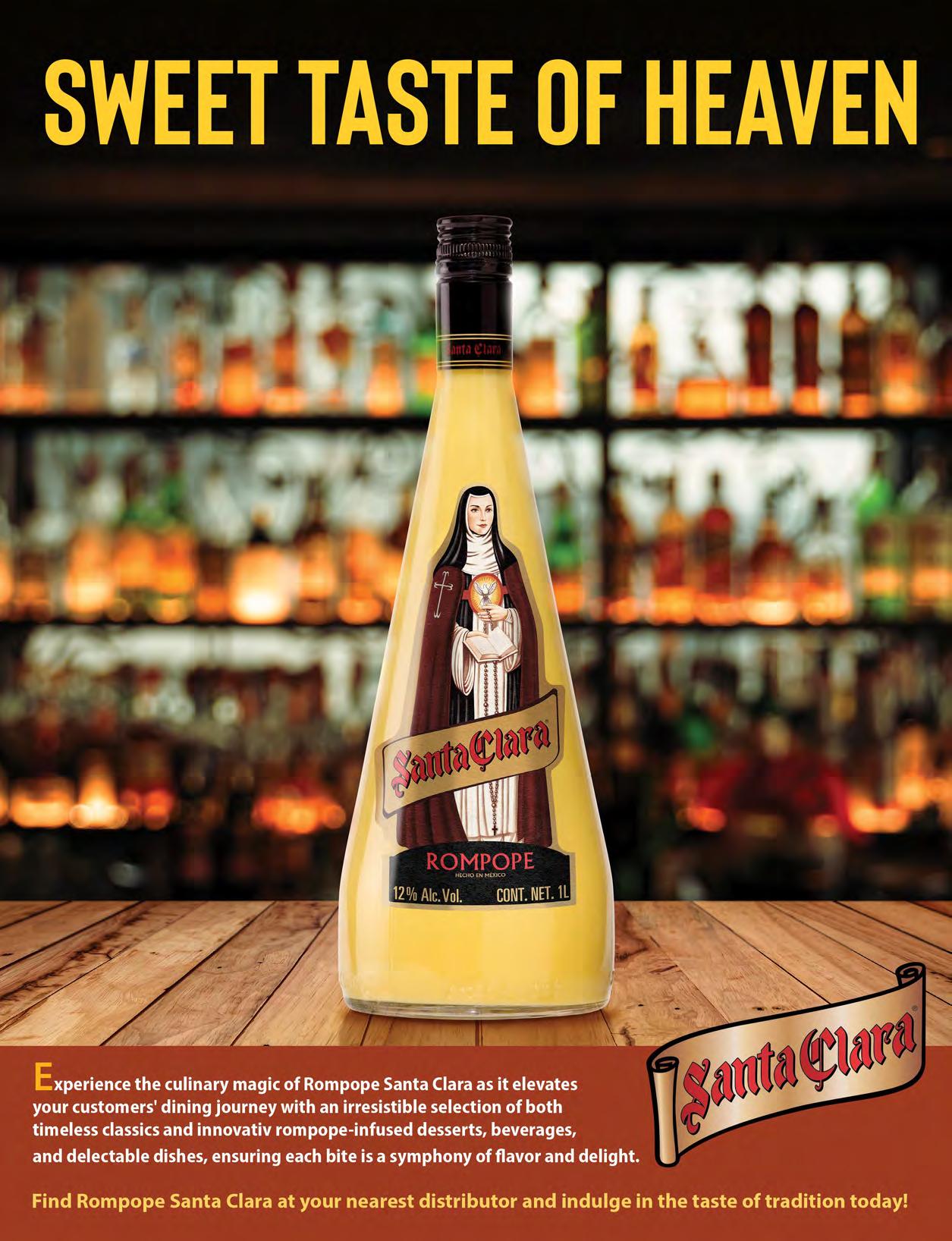
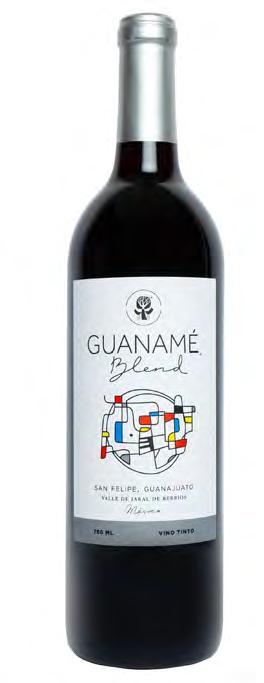
Mexican wineries tend to be small, boutique businesses…Fortunately, a growing number of those boutique wineries are now producing reliable quantities and exporting to the United States .
Llano Colorado Lagrimas Verdejo (Baja California). Famed winemaker Lourdes “Lulu” Martinez Ojeda crafted this white wine, which is made entirely with Verdejo grape. It pairs well with fish, seafood and soft cheeses. Retail price: $20 to $25.
Casa Jipi Nebbiolo (Baja California). Casa Jipi (pronounced “hippy”) is another project of Lulu Martinez Ojeda. This Nebbiolo features “vibrant fruit notes of ripe raspberry, strawberry and red cherry.” Retail price: $22 to $32.
Guaname Blend(Guanajuato). One aspect of Guaname wines that customers love are the labels, all inspired by Picasso’s cubist paintings. The Guaname Blend is 60 percent Malbec, 20 percent Syrah, 15 percent Tempranillo and 5 percent Merlot and has “aromas of blueberries and blackberries, with a touch of black pepper.”
Retail price: $23 to $33.
Parvada Cardenal (Coahuila). This wine is made with 50 percent Calladoc and 50 percent Malbec grapes. It has a purple/violet color, with “complex aromas of red fruits, spices and fresh vegetable notes.” This wine would be for customers willing to spend a bit more, as its retail price is $40 to $50.
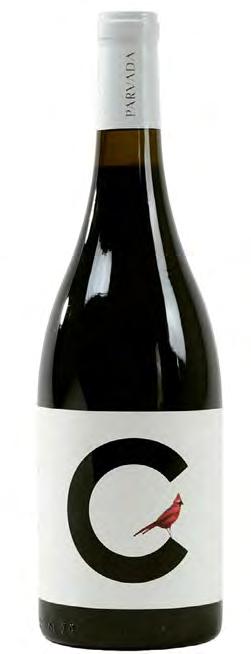
Tres Raices “Tre” Sangiovese (Guanajuato). This wine from central Mexico is made with 100 percent Sangiovese grapes and “is fresh and fruity, with concentrated cherry, strawberry, and blueberry notes, and a round palate with light and silky tannins.” Retail price: $25 to $30.
Adobe Guadalupe Gabriel (Baja California). The 2019 vintage of this blend of Cabernet Sauvignon, Malbec and Merlot is rated in the top 1 percent of wines of the world, according to wine app/marketplace Vivino. It has “aroma notes of mocha, vanilla, caramel, cherry and raspberry.” This is another red for customers willing to spend more; its retail is $40 to $70.

These are just a sampling of quality Mexican wines available in the United States, and we would love to hear about others you are putting on your menu! Please send your suggestions to Ed Avis at edavis@elrestaurante.com so we can share them with other readers.


2 oz Tito’s Handmade Vodka
4 oz watermelon agua fresca
½ oz lime juice
½ oz watermelon puree
1 slice watermelon, garnish
Add all ingredients to a shaker with ice. Shake and strain into a glass with fresh ice. Garnish with mint leaves and a watermelon slice.

| BY PAOLA ORTEGA
| When TikTok restaurant influencer Keith Lee ordered a birria taco at Taqueria Tlaxcalli in Parkchester, New York, no one behind the counter — including long-time Chef Johnny Bautista — realized who they were serving.
And then things took a very unexpected turn!
Lee, who boasts more than 16 million followers and selects mom-and-pop restaurants based on followers’ suggestions, “blessed” this neighborhood restaurant in The Bronx with a January 19 post in which he praised the taco as one of the best he’d had in a long time.
“It was a crazy first two weeks when it happened,” manager Rosa Gomez recalls. “We had birria on the menu when birria started trending, but we didn’t really make it as much because
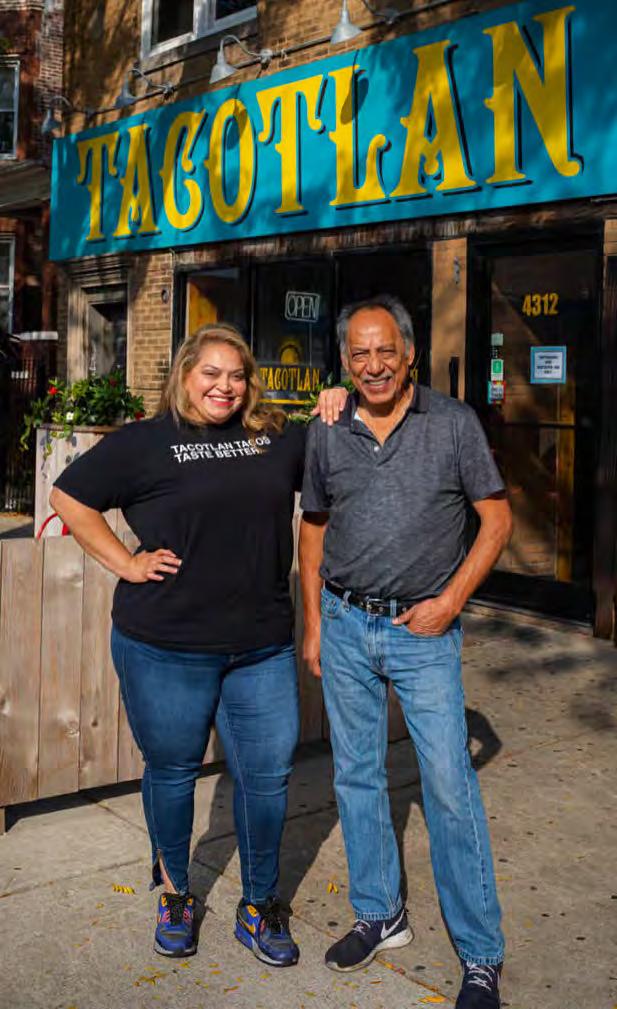
it was something that wasn’t selling, but after that video — because that was the food he spoke about — we had to quadruple our portions just so that we could keep up with the demand that was coming off of that.”
And if you wonder how much mileage a restaurant really gets from a single TikTok post, consider this: after Lee’s post, Taqueria Tlaxcalli’s follower count on TikTok surged from twenty to over a thousand, and the restaurant enjoyed a boost from local press coverage, including a feature on News12.
A similar situation unfolded when he “blessed” Tacotlán in the Hermosa neighborhood on Chicago’s northwest side with a rave review of the quesabirrias in July. Sales doubled daily, and the restaurant’s follower count skyrocketed from 27,000 to 33,000.
Jessica Perjes, co-founder of Tacotlán, says the impact from what’s been dubbed the “Keith Lee Effect” was crucial for exposure.
“It was important in the sense that we needed to tell other people that maybe did not know about us that we’re even there in Chicago,” she says.
It’s clear that TikTok is a social media platform that Mexican restaurants should consider adding to their arsenal of promotional tools.
“The game has changed 100 percent,” says Perjes. “It’s not, ‘Should I do it?’ No, it’s, ‘You have to do it.’ You need to be everywhere that a customer is at.”
While other social media platforms charge marketing fees to reach a broader audience, TikTok doesn’t. Its algorithm ensures that your content is spread far and wide, making brand awareness and connecting with your target audience quite easy.
“I
post my feelings, the food that we’re serving. I post specials, I post how busy we are at certain events, what events we’re being a part of; collaborating with other restaurants, what specials we have together. I’m constantly posting anything that happens on a daily basis.” –
JESSICA PERJES,
Tacotlán

“It can be overwhelming for clients when they look at the menu,” Gomez explains. “If they’re able to see the different foods that you have through social media, they can be like, ‘Oh, I want that,’ so that boosts sales for different food items.”
Sometimes it is easy to tell that someone is dining for the first time based on a TikTok post because they mention they found your restaurant on the platform, Gomez says. Other times, there might be clues that they’re not regulars.
It’s become almost undeniable that TikTok is an important weapon that restaurants can wield in the battle to cultivate customers.
Toast cites a 2021 study showing that 36 percent of TikTok users have visited or ordered food from a restaurant after seeing a TikTok video about the restaurant, and a 2022 survey by national franchising experts MGH revealed that 53 percent of millennial TikTok users and 38 percent of TikTok users across all generations have visited or ordered from a restaurant after seeing a video about it on TikTok. And it’s pretty safe to assume those percentages have climbed even higher in the years since that data was collected. Getting started on the platform is easy — just create a business account and add your restaurant name, logo, and link your website in your bio. Things get a little more complicated from that point, but here are some content ideas from the pros at Toast:
• Give a restaurant tour
• Introduce some of your staff and what they do
• Show off both new and classic menu items
• With permission, capture satisfied customers on video
• Teach your followers a new recipe
• Tap into TikTok trends and post one of your own (this is key to going viral)
• Make sure you use popular TikTok sounds in the background (also major key!)
• Show off new specialty cocktails and your bar
A
INTO THOSE TIPS, SEE THE TOAST BLOG POST HERE Want to know more? Toast recommends checking out these posts:
• How to make a TikTok go viral as a complete beginner
• How to make a TikTok: Everything you need to know
• How to record and edit videos in TikTok
Have you had great success with TikTok? Send your story to Editor Kathleen Furore at kfurore@restmex.com and we’ll feature it on our website and social media platforms.
“I feel like we could identify them by the fact that they don’t know the process or are looking around like they don’t know how to order,” Perjes says.
On TikTok, non-salesy and authentic content is essential for engaging existing customers and helping to attract new ones.
The process can be as simple as using your phone to film behind-the-scenes content and editing the video within the app, Perjes explains.

“I post my feelings, the food that we’re serving,” says Perjes. “I post specials, I post how busy we are at certain events, what events we’re being a part of; collaborating with other restaurants, what specials we have together. I’m constantly posting anything that happens on a daily basis.”
While being on the platform is important, Perjes emphasizes that it shouldn’t be too time-consuming.
“I don’t overthink it at all,” she says. “I feel like if it looks good, if it makes me hungry and makes me want to come into the restaurant, then that’s what I post.”
Creating unfussy videos and participating in trends can help restaurants reach more people, but Gomez and Perjes believe that telling the story behind your business is what makes them stay.
“It’s still something very new to us and something we’re still trying to figure out,” shares Gomez. “Even though it can be a lot of work, I do think it’s very important to use that platform to your advantage.”
“After Keith Lee came, my sister talked about her experience, how we were going to improve, anything that people were liking about how we handled our process, and that got over 300,000 views,” says Perjes. “The effect afterwards — people walking in through the door — that also got another 300,000 views.”
“There are so many of us, and in a way we’re all the same,” says Gomez. “But in the same way we’re also different. [TikTok] lets you showcase the kinds of qualities that make you stand out.”
And what if your first TikTok post doesn’t generate much buzz? Is it time to call it a day?
Gomez stresses that an ongoing commitment to the platform is essential for success
“Like anything in life, you have to be very consistent and persistent,” says Gomez, who notes that it could be “one out of the million videos that you put out” that “will literally blow up!”
Paola
Ortega is a Chicago-based writer and frequent contributor to el Restaurante
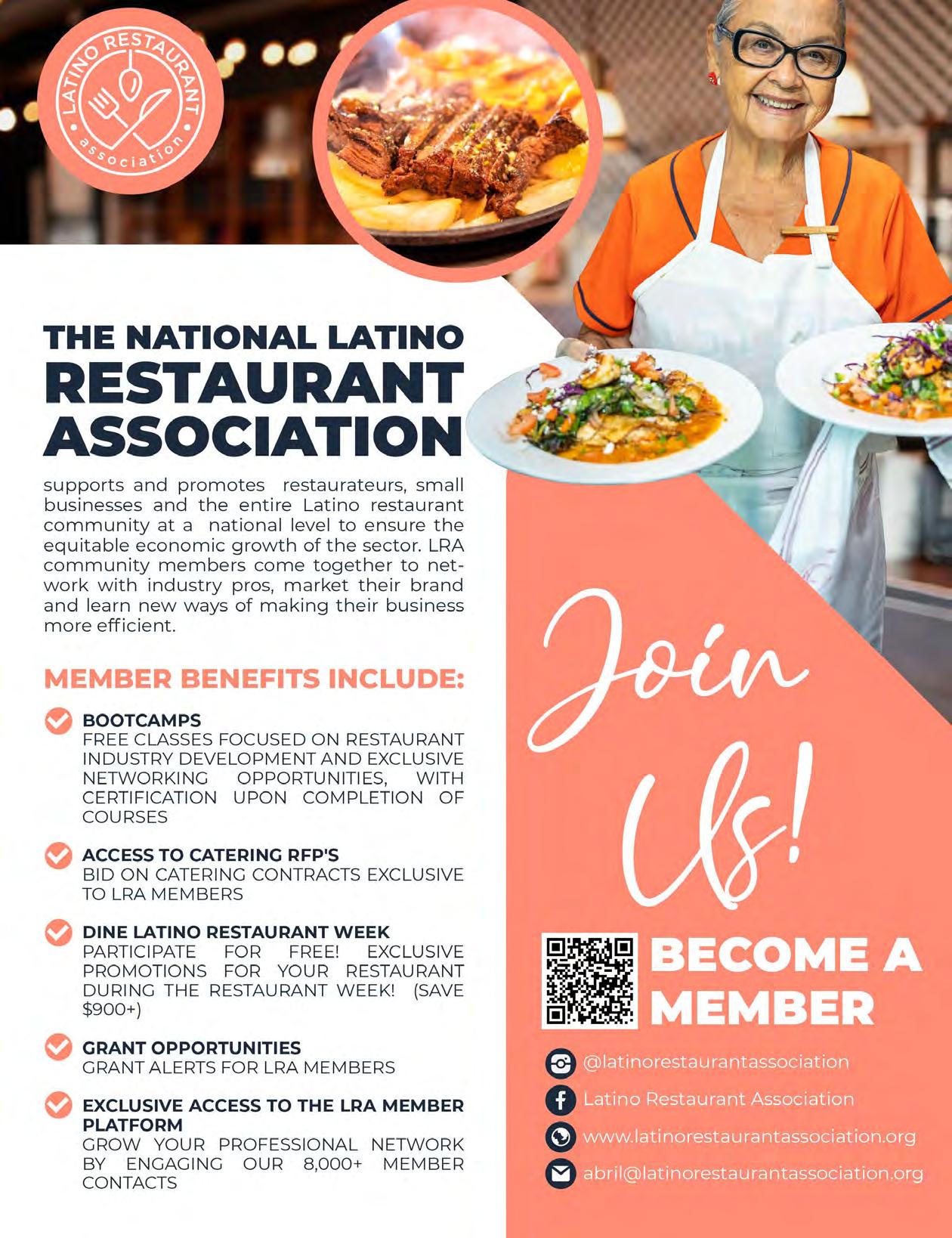
NOVEMBER/DECEMBER
• Our Annual Buyer’s Guide: Special Offers for Advertisers!
• Cover Story: Soups & Stews
• Special Repor t: 10th Annual Independent Mexican Restaurant Report
• Culinar y Trends: Tamales
• At the Bar: Making the Case for “Mocktails”
• Business Basics: Evaluating Off-Premise Options
AD CLOSE: OCTOBER 25
MATERIALS DUE: OCTOBER 31



IQ Risk Insurance Services. This full-service insurance brokerage firm offers products to protect your business including property/ casualty, general liability, worker’s compensation and more. Licensed nationwide. insuresmarter.com
Citrus America. Save time and labor in the kitchen and behind the bar with this line of food grade stainless steel commercial citrus juicing equipment that includes a variety of juicers, plus pressing kits great for juicing citrus for Margaritas and other cocktails. citrusamerica.com


De La Calle Tepache. Tepache — the fermented beverage that starts with a simple core recipe of pineapple, pineapple rinds, cinnamon and sugar — is showing up in restaurants and bars, often in mezcal and tequila cocktails. Now, the founders of De La Calle are giving tepache a modern take with their canned products available in 10 creative flavors: Mango Chili, Tropical Ponche, Tamarind Citrus, Grapefruit Lime, Pineapple Spice, Prickly Pear, Watermelon Jalapeño, Hibiscus Citrus, Ginger Manzana, and Pineapple Chili. delacalle.mx
C.T. Beavers. Get ready for tamale season with the Tamale King tamalemaker, plus the company’s line of tamale pots, corn husks, masa and spices. Four models available for any size restaurant. tamaleking.com


Contigo® Cocktail-inspired Desserts from Performance Foodservice. The gluten-free Piña Colada Cheesecake blends the creamy richness of cheesecake with the exotic flavors of pineapple, coconut, and rum. The Strawberry Margarita Pie combines the classic flavors of a Margarita with a decadent key lime pie base, ripe strawberries and a gluten- free crust. Infused with tequila and a splash of lime, it’s topped with macerated strawberries. performancefoodservice.com
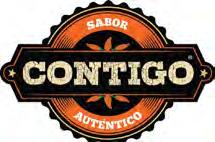

Seis Soles Wines. Mexican-American winemaker Chris Rivera’s parents immigrated from central México, where the Aztecs believed the world had been created and destroyed in four cycles, giving way to life under the fifth sun. He named his company Seis Soles, the sixth sun, to represent the growth of his generation’s culture and values, which is reflected in the company’s premium hand-made California wines: Grenache & Mourvedre Rose, Grenache Blanc & Albariño white blend, Tempranillo, Red Blend, Gran Reserva Cabernet Sauvignon, SolTierra, and ‘Colibri’ Lodi Carignane. 6soles.com





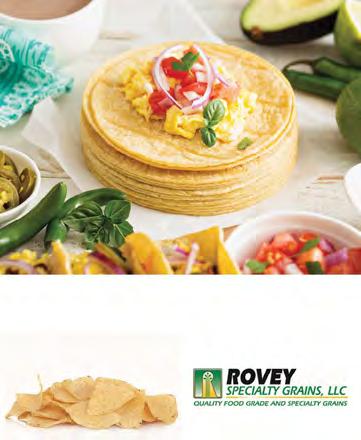




Roasted Pacifico Striped Bass
Recipe and photo by Ben Diaz
Makes 1 serving
1 each side Pacifico striped sea bass
1 t. lemon zest
2 t. lime zest
1 t. guajillo powder
1 T. brown sugar
2 T. kosher salt
1 T. rosemary mince
1 t. garlic paste
2 oz. olive oil
Salsa Para La Mesa (recipe below)
In a small bowl add lemon zest, lime zest, guajillo powder, brown sugar, kosher salt, minced rosemary and garlic paste. Gently combine to form a semi-wet rub. Gently brush bass with olive oil on both sides. Generously coat bass in the semi-wet rub and allow to marinate for 1 hour. Place bass on a baking pan lined with parchment paper; bake at 400°F for 12 minutes.
To ser ve: Gently flip the bass skin side up and serve with your favorite sauce. Garnish with edible flowers.
The Salsa Para La Mesa*:
10 lbs. Roma tomatoes
2 lbs. tomatillos
5 each jalapeños, no stem
1 lb. onions, cut into quarters
10 each guajillo chiles, stemmed and seeded
30 each chile de arbol, stemmed and seeded
2 T. cumin seeds
4 T. Mexican oregano
½ c. garlic cloves
1 c. fresh cilantro
1 c. fresh lime juice
4 c. olive oil
Kosher salt, to taste
Place tomatoes, tomatillos, jalapeños and onions on a baking pan and roast at 400°F for 20 minutes (should be dark, almost burnt).
Soak the guajillos and chile de arbol in warm water for 5 minutes then drain. In a small saucepan, add cumin seeds and Mexican oregano, lightly toast until aromatic; set aside.
In a large blender add roasted tomatoes, tomatillos, jalapeños, onions, dry chiles, garlic, cumin and Mexican oregano. Lightly pulse until the ingredients have broken down into a chunky salsa consistency.
Next add the lime juice and cilantro, then blend on high. While blender is going, slowly pour in the olive oil. Continue blending until the oil has been fully absorbed. Season to taste with kosher salt.
*Sauce should be silky, smooth with bright colors and a rich flavor.
Chiles En Nogada
Recipe ©Iliana de la Vega, 2024
Makes 8 portions
The Filling:
¼ c. canola oil
¼ c. white onion
½ lb. pork shoulder, finely chopped
½ lb. beef round, finely chopped
1 lb. R oma tomatoes, very ripe, diced
1 ea. Golden D elicious apple, peeled and diced
1 ea. Anjou pear, peeled and diced
½ ea. plantain, r ipe, peeled and diced
¼ c. almonds, blanched and chopped
¼ c. black raisins, chopped
¼ c. candied pineapple**, diced
¼ t. Mexican canela, ground
Pinch of cloves, ground
Salt, to taste
The Nogada + Chiles:
1 c. walnuts
2 oz. almonds, blanched
7 oz. goat cheese or Mexican queso fresco
Milk , whole, as needed
1 t. sweet sher ry (optional)
Sugar, to taste
Salt, to taste
Pepper, white, ground, to taste
8 ea. poblano chiles, 1-in. cut at tip of chile, fried until blistered, cleaned
½ c. pomegranate seeds, for garnish
¼ c. Italian flat leaf parsley, finely chopped, for garnish
Heat oil in a Dutch oven and sauté onion until translucent. Do not brown.
Add chopped meats and fry until browned. Add tomatoes and cook until the meats are tender and fully cooked, about 15 minutes.
Reduce heat and add apple, pear and plantain. Cook for 5 minutes.
Add almonds, raisins, pineapple, canela, cloves and salt to taste. Continue cooking, stirring occasionally, until juices evaporate. Remove from heat and cool the picadillo to room temperature.
Puree walnuts, almonds, cheese and milk to taste. The mixture should be thick and nutty. Season with salt, pepper and sugar to taste (add sherry at this point). Cover and refrigerate.
Stuff chiles with the picadillo. The chiles should be full and barely able to close. Cover chiles with the walnut sauce and garnish with pomegranate seeds and chopped parsley. Serve at room temperature.
**In Mexico Acitrón is used as part of the stuffing. As it is unavailable in the U.S., I suggest the closest flavor: candied pineapple.
GERRY TORRES KNOWS A LOT ABOUT TACOS
— and this Mexico City native who spent much of his youth in Tijuana and San Diego has turned that knowledge into a menu featuring 20+ renditions of that popular street food at City Tacos, a restaurant he launched in 2014 in North Park, California, with a menu of four tacos.
The restaurant now boasts eight San Diego area locations with a menu that features tacos in myriad varieties — everything from traditional options (chicken, carne asada and carnitas) to caseros “homestyle” tacos (pulled pork with mayan achiote sauce, beef shank, mahi mahi), and several other meat, seafood, vegetarian, and vegan options.
One of the most unique varieties coming out of the kitchen is Chef Eduardo Baeza’s Taco Placero — a corn tortilla topped with watercress, pork rinds and cactus salad, crowned with an avocado sliver, and served with pickled jalapeños or fresh salsa of choice.
And why did Torres select the Taco Placero as a favorite?
“Simplicity makes individual ingredients pop. Taco Placero provides a potpourri of flavors that your taste buds will love, and you’ll probably want to eat a second and third,” Torres says. “It’s a great, light option with a crunch for taco lovers.”

Taco Placero
The Taco: Corn tortilla Avocado Pork rinds
Cactus salad (recipe below)
Papalo (substitute with watercress if not available)
The Cactus Salad:
4 clean cactus leaves
3 Roma tomatoes
1 white onion
5 oz. mild ricotta or mild feta cheese
1 sprig cilantro
1½ oz. olive oil
Salt, to taste
Dry oregano, to taste
Fresh lime juice from one lime
Wash cactus thoroughly and remove any thorns, cut in half-inch-thick slivers, and place in a pot of water with salt; cook for approximately ten minutes or until soft (al dente). Once the cactus slivers are cooked, strain them and allow them to cool to
room temperature. Chop the Roma tomatoes and ricotta or feta into cubes and slice the onion into thin slivers. Finally, mix it all together in a bowl and add lime juice, desired salt, oregano, olive oil and fresh cilantro.
To build the taco: Place a warm corn tortilla as a base. Add papalo or watercress, pork rinds and cactus salad, crown with avocado sliver, and serve with pickled jalapeños or fresh salsa of choice.
